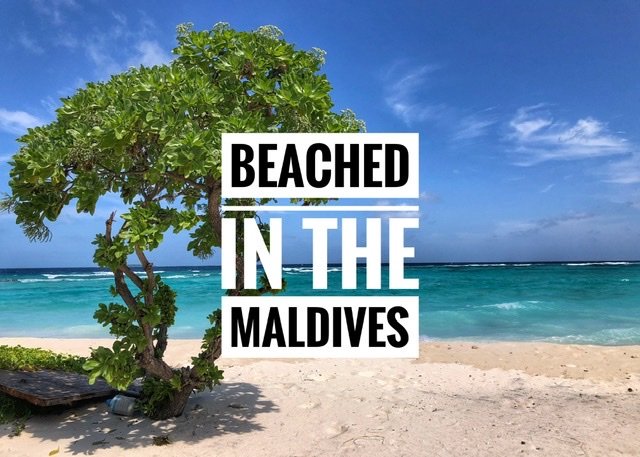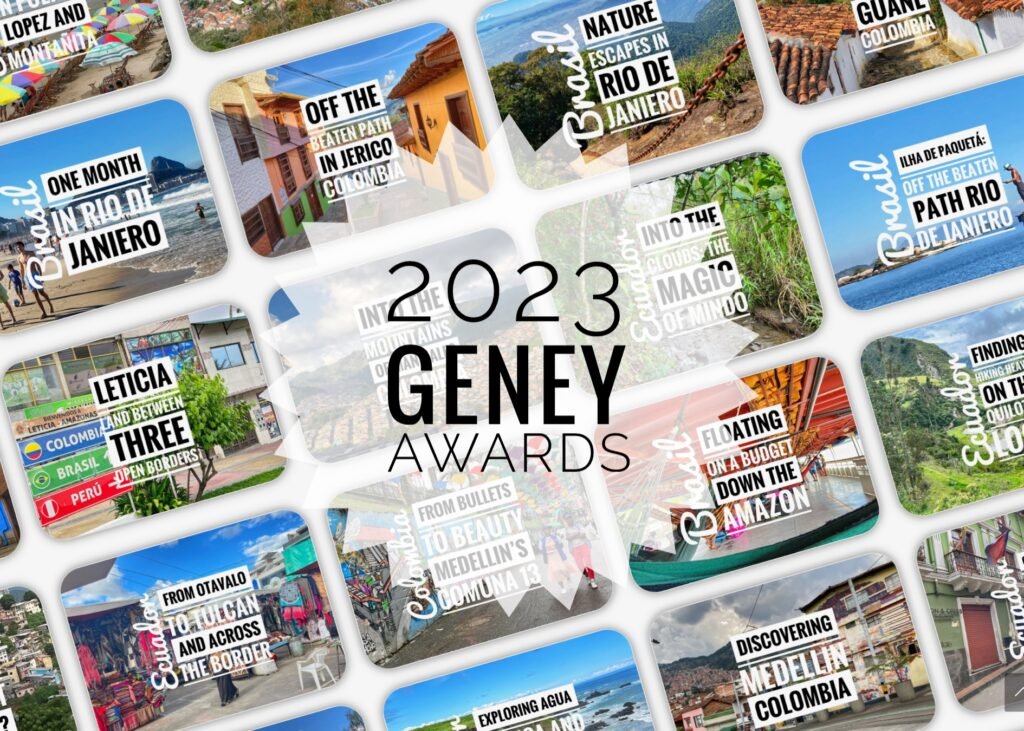
2023 started with sickness, cold and challenges in Northern Europe and ended with different sickness, cold and challenges in Indiana (US), but the filling of this annual sandwich was generally quite warm and rewarding as we gallivanted South America like we’d never done before. We got to see and do things parked on our “60 by 60 Lists” like go canyoning down a waterfall, take a slow boat cruise down the Amazon, gaze at the magic of the Salar de Uyuni, and sleep in a bubble.
Some other highlights included the return of friends and family traveling with us, meeting lots of local friends through Couchsurfing, encountering our first person who has been to every country on earth, being able to hold extended conversations in Spanish, witnessing the largest waterfall on earth and also the highest peak in the Americas (Mount Aconcagua).
Over the course of the year, we visited 13 countries on three continents, including Belgium, UK, Canada, US, Panama, Ecuador, Colombia, Brazil, Uruguay, Argentina, Paraguay, Bolivia and Chile. Among these included five new countries, including one that shot to the top of our “favorites” list after some extended time.
Some budget statistics for the numbers nerds:
- On the budget front, we spent a total of $17,492 or an average of $47.92/day, or $758 under our $18,250 budget. ($50/day).
- The biggest budget challenges this year included lack of housesit options in South America, two expensive months back to back (Brazil) and the Bolivian visa.
- Biggest money savings included Couchsurfing, Hopper credits for free hotels, and free flights (see below).
- Our most expensive month was June ($1989) which is when we were moving through the Amazon, and ending the month in not-so-cheap Rio de Janiero. Our least expensive month was November ($998) in NW Argentina.
- Our most expensive country was surprisingly Bolivia at $54.80/day or a total of $1644.28 for 30 days. This is only because US Citizens are required to buy a hefty $160 visa (each) to enter. We also did not have any free accommodation while in Bolivia.
- Our least expensive country was Panama at $28.79/day or a total of $1813.63 for 63 days. 58 days of this sit were at our favorite jungle housesit. This was an ideal way to set up the year for financial success early on, as well as have some much needed downtime.
- We took 8 flights over the course of the year and spent a total of $556.22 on them. Only two of them were paid out of pocket ($333) and the rest purchased with credit card points (some of which had taxes.) Our favorite travel rewards credit cards continue to be: Capital One Venture X, Capital One Venture, and Chase Sapphire Preferred. Other than that, we spent $2421 on other transportation including buses, boats, and gas (US & Panama).
- We had 204 nights of paid accommodations, which were mostly booked through Booking, Airbnb, Agoda or Hopper. The rest of the year was free through Hopper or credit card travel credits, housesitting, couch surfing, or staying with friends/family. Our average cost/night on paid accommodations was $25.75.
- Our annual grocery budget was $4308 and we spent $2305 eating out in restaurants, which also included sweet treats and alcoholic delights.
Indeed! It’s been quite a year! So without further adieu, we bring to you our sixth annual Geney Awards:
Best Cultural Experience

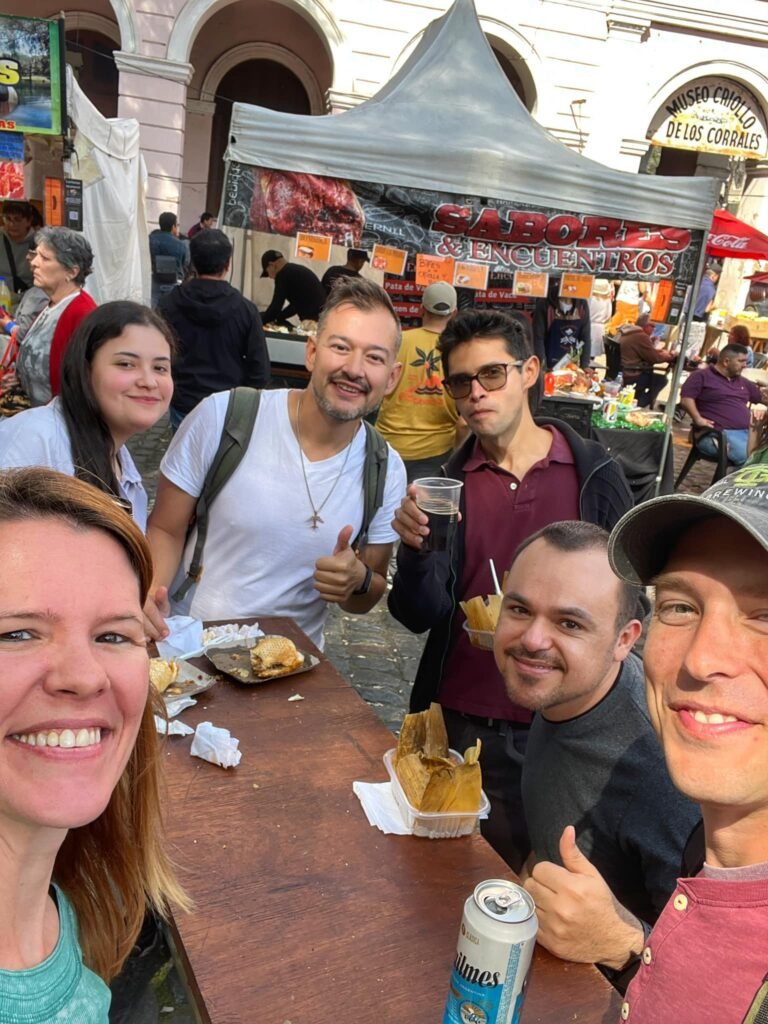
Feria Artesanal Mataderos, Buenos Aires, Argentina
On September 10, we joined a group of mostly locals for a Couchsurfing meet-up at an off-the-beaten-path authentic artensanal fair on the outskirts of Buenos Aires. This fair, held every Sunday, offers a vibe of the “gaucho” (cowboy) side of Argentina. It featured adorable local couples performing folk dances, food stalls dishing out hearty Argentine traditions and tons of vendors selling uniquely Argentine goodies. Our group consisted of two Colombians, two Pórtenos (from Buenos Aires), a French guy living in BA and a Mexican guy living in the States. It was full Spanish immersion that day, although there was also a sprinkling of English. Read more.
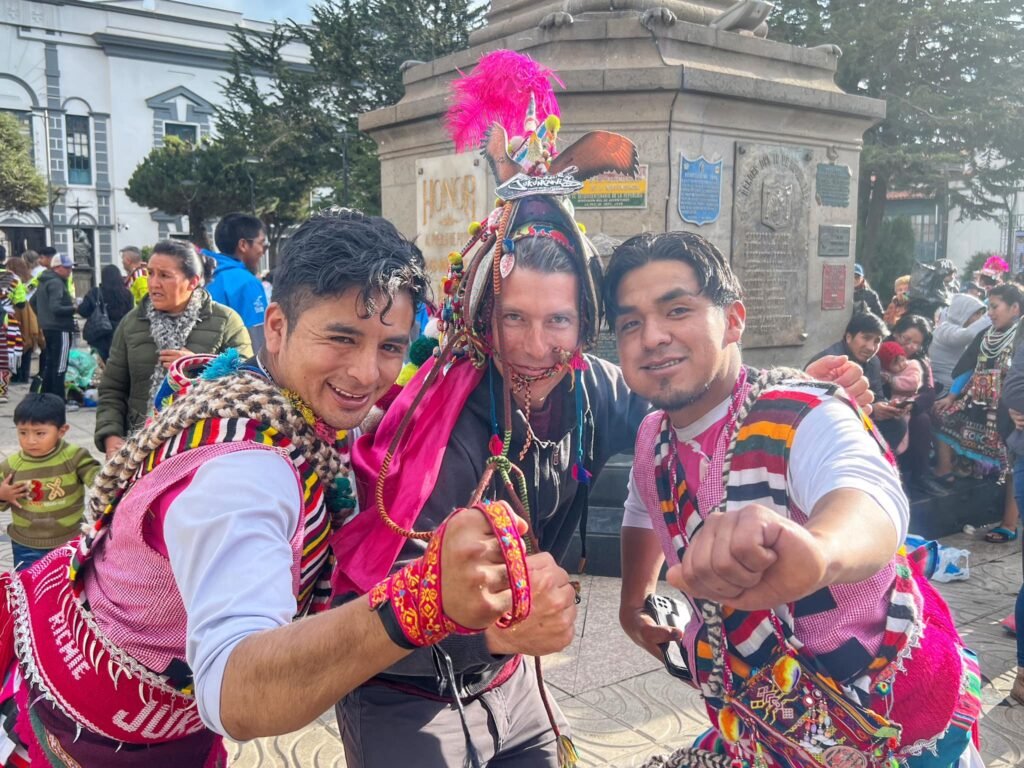

Honorable Mention: Festival in Potosi, Bolivia
Potosi’s remote location and less touristy appeal offers a chance to immerse yourself in the true essence of Bolivian culture. On the Sunday we arrived, we even got lucky enough to stumble on a festival which was wrapping up. While there, we got snagged for dress up, and offered beer by some local performers. Mandy loves to dress up so she was totally game, but Greg had to be tortured into the spotlight just a bit. The next morning at 7:30 we again stumbled upon some sort of military procession, which included a bizarre pride of…mountain lions? We have no idea what they were doing there but they were quite a hilarious contrast amongst the very official Bolivian police force.
Most Unique Stay
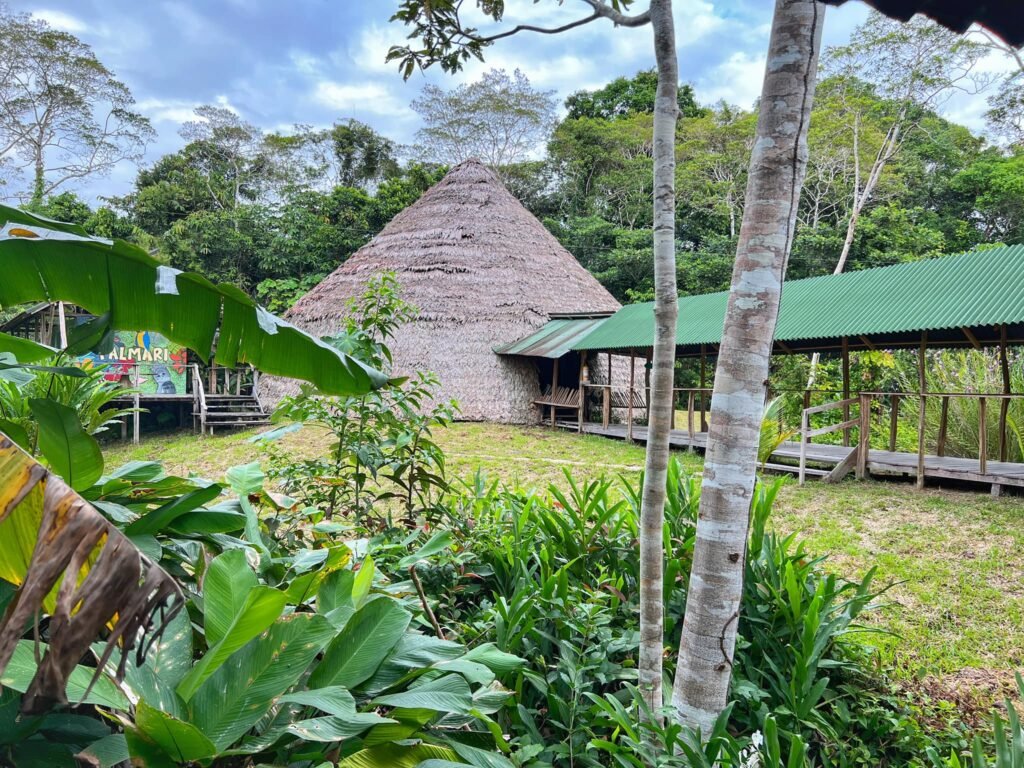
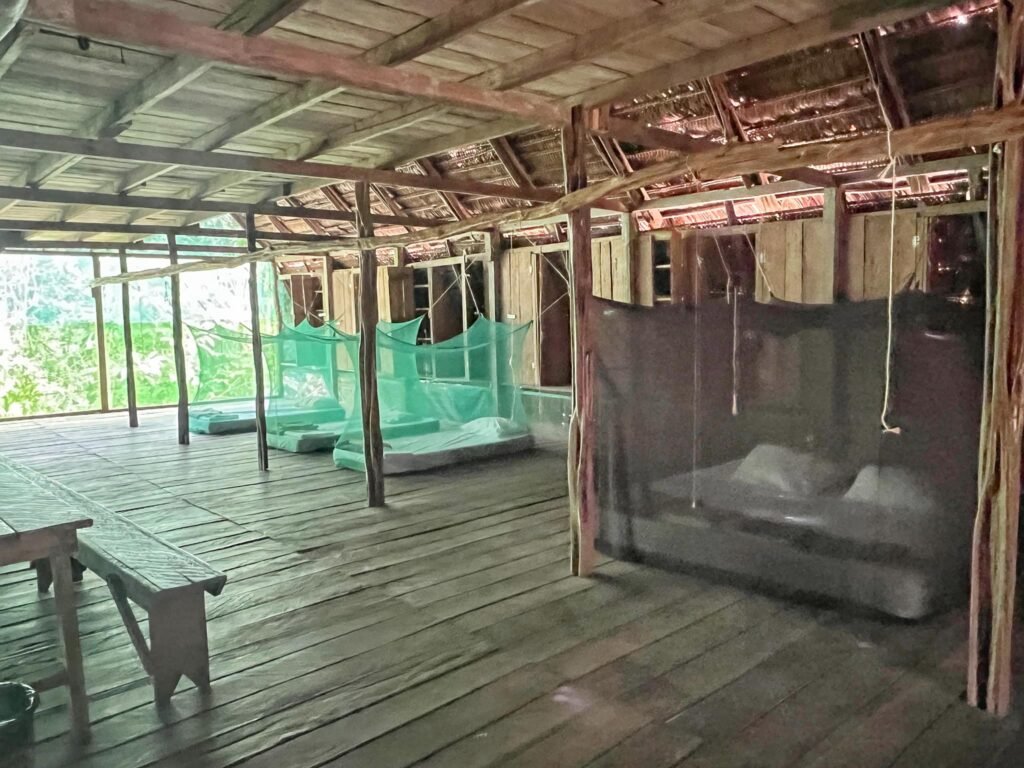
Reserva Natural Palmari, Amazonas, Brasil
Our stay at Palmarí Nature Reserve was like going to the most fun jungle summer camp ever for like-minded adults of all ages. With free beer. Errr….well, not exactly free but along with really top-rate meals and activities, it was included in our daily rate which for us was $80/person. Yes, a major splurge for us, but undoubtedly worth every peso and a fabulous and authentic way to have a rustic experience in the Amazon for three nights. (Which we could have easily done more!)
Palmarí was developed by a German PhD named Axel in ornithology about 20 years ago. He created the reserve in order to protect and study bird and other species of the Amazon and it has developed into a full-blown lodging and experience operation run by at least 70 local staff members and volunteers from all over, who serve as translators. Read more.
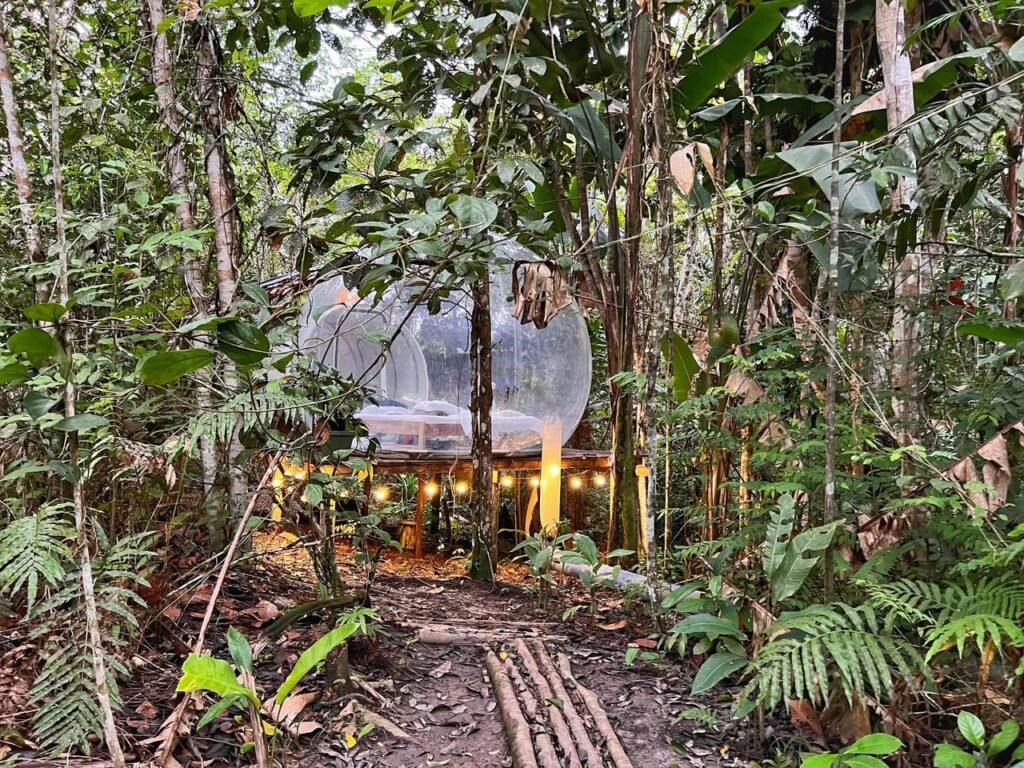

Honorable Mention: Glamping Amazonas, Leticia, Colombia
As you can see, there are a LOT of ways to experience the Amazon…from super rustic to super luxurious to everything in between. Because we knew this was a once-in-a-lifetime opportunity, we decided to maximize our experience and not to stick to our normal $50/day ($1500/month). If we had wanted to do so, it would have been (close to) possible by staying in Leticia and doing excursions from there. However, we definitely would have missed out by not staying in the jungle.
Instead we chose these two experiences far from the town. The first, which we called “Amazon Light,” took us 30 minutes up the river further into Colombia to “Glamping Amazonas” where we slept tucked back into the jungle inside a burbuja (bubble), which was absolutely unreal and we highly recommend. The second, of course, was the nature reserve. Read more.
Most Outstanding Accommodation
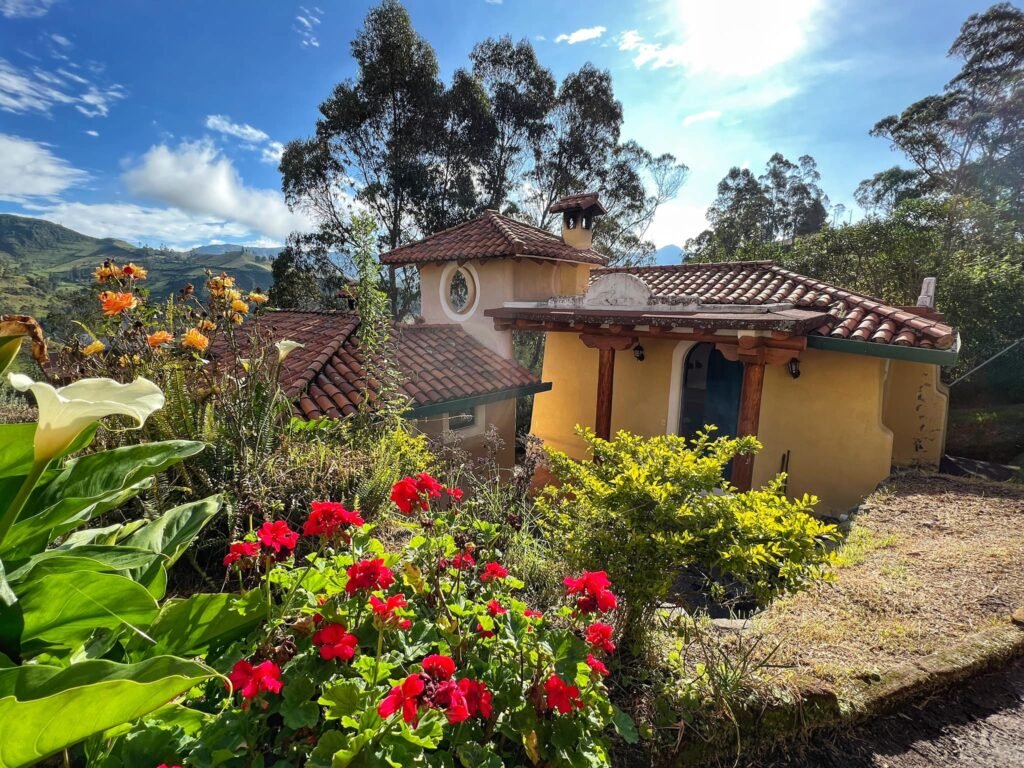
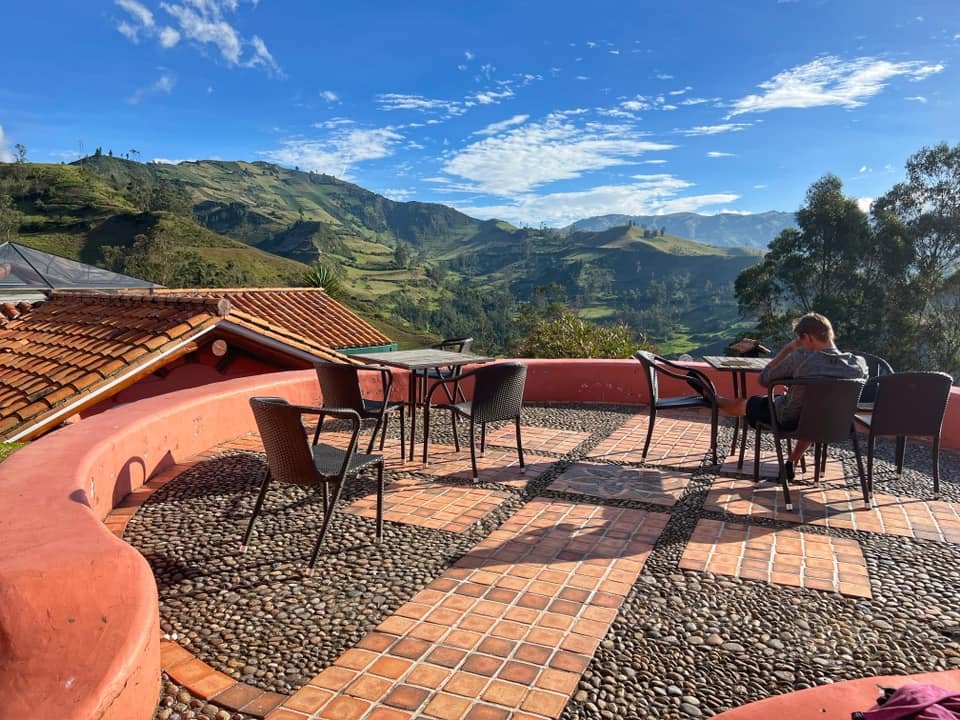
Lllulu Llama Lodge, Quilotoa Loop, Ecuador
For our first night trekking the Quilotoa Loop, we stayed at a lodge that is recommended far and wide in Ecuador and for absolutely good reason…Llu Llu Llama. This eco-friendly retreat is absolutely unbelievable for its remote village location tucked into the pristine Andes. Two and a half hours from Quito, it can only be reached by hiking, as we did, or by very very slow, local bus. Our $50 a night stay was all-inclusive with a phenomenal three-course dinner and breakfast, (meeting our dietary preferences) as well as yoga facilities. It also included a jacuzzi and steam room for an extra $5. Read more.
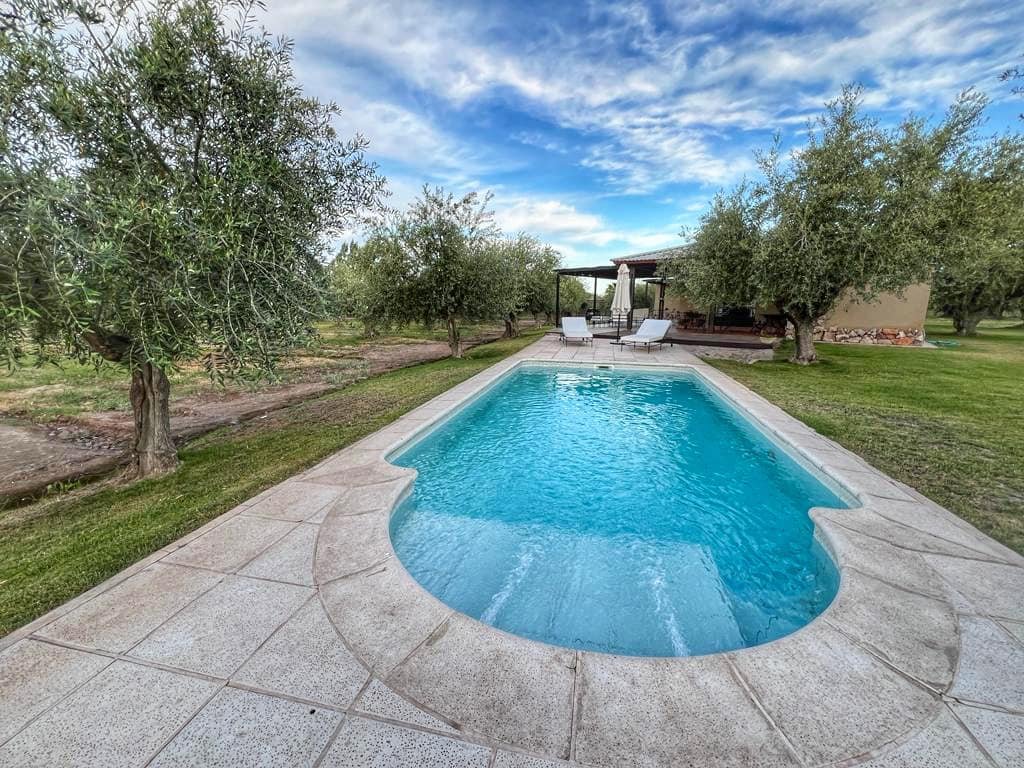
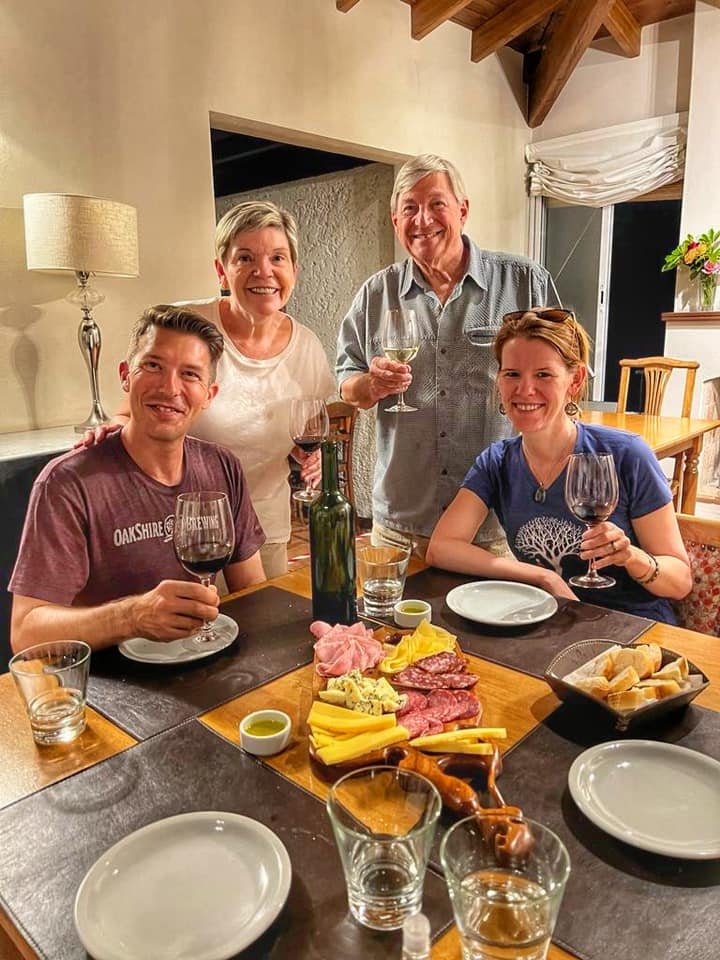

Honorable Mention: Posada Oliva Verde, Mendoza, Argentina
Greg’s parents, Larry and Grace, joined us for our travels during November 2023 in Argentina. On the last five nights, they treated us to a very special private villa on a vineyard, which was founded in 1889. The cost on Booking was listed at $2300 for the five nights, but thanks to the Blue Dollar rate it was an absolute steal (for them!) at $940. It included a stellar breakfast every morning, private pool, hour-long massages for about $10, a space for yoga and relaxing and of course, as is required in this part of Argentina, some very delicious wine.
Best Unpaid Accommodation


Mount Pleasant Neighborhood, Washington DC, USA
Although our sit in Bucaro, Panama will forever be one of our favorite housesits, we’ve already given it the award in this category in 2021. Thus, this year we gave the award to our other favorite housesit, which lasted two weeks in a lovely row house with two precious kitties in DC. We chose to go to DC because Greg had never visited and we were eager to explore the museums, charm, international flavor, and wide range of ornamentation and architectural delights. The house that we stayed in was surrounded by heritage trails, an enormous park, and everything is pedestrian-friendly and interesting. It was perfect for two wandering walkers like ourselves. Plus, the grunting-noises coming from CBD…yes…that was the name of this cat, was absolutely priceless. Read more.
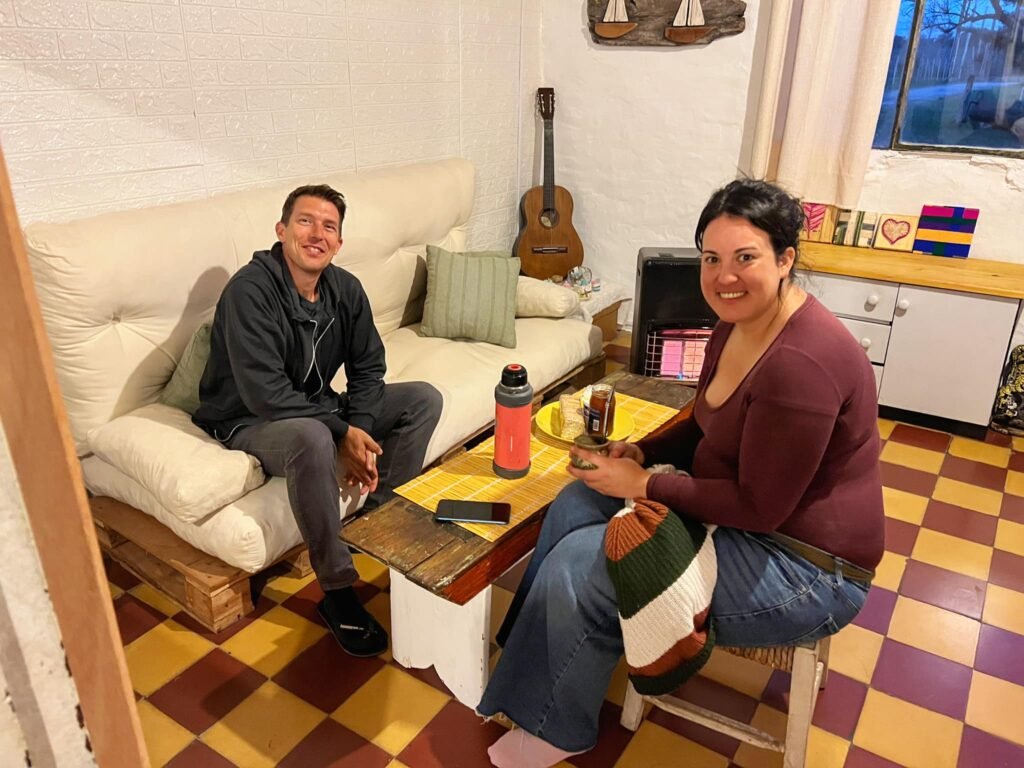

Honorable Mention: Couchsurfing with Eva, Colonia del Sacramento, Uruguay
We knew we wanted to experience the real Uruguay, so what better way to do so, while also saving on accommodation, than a rural Couchsurf homestay? Our Spanish-only speaking hosts, Evangelina and her papa Daniel, could not have been more kind. Eva even let us stay in her simple and cozy casita, while she stayed with her mom down the road, so we had our own place with a kitchen and bathroom, while her papa lived next door. And, we certainly got the full Uruguay package…maté, horses, grilled meat over the fire and…absolute tranquility, which is one thing that was consistent during our time in the country. (Most likely due to the winter season.)
When we arrived, Evangelina picked us up at the bus station near the historic center of Colonia. Although she lived about an hour’s walk from the center, she told us she’d be happy to also be our chauffeur! Wow! What a hostess! We swung by the market on our way to the house to pick up a few things, which definitely made life easier. Read more.
Most Picture Perfect Village


Paraty, Brazil
If a time-warped charm land like this were dropped in Europe in August, it would be gushing with tourists, unbearable heat and ways to burn your wallet. But in Brazil’s winter, you can find an exquisitely preserved Portuguese colonial jewel with a fraction of the crowds and cost, divine sun drenched and spring-like weather, and a legit wow-factor at every turn. Welcome to Paraty, founded in 1597, sometimes known as the “Venice of Brazil” due to its monthly flooded streets, four hours west of Rio de Janiero. It is a well-deserved UNESCO World Heritage site, reflected in its unique culture, architecture and natural biodiversity. Read more.

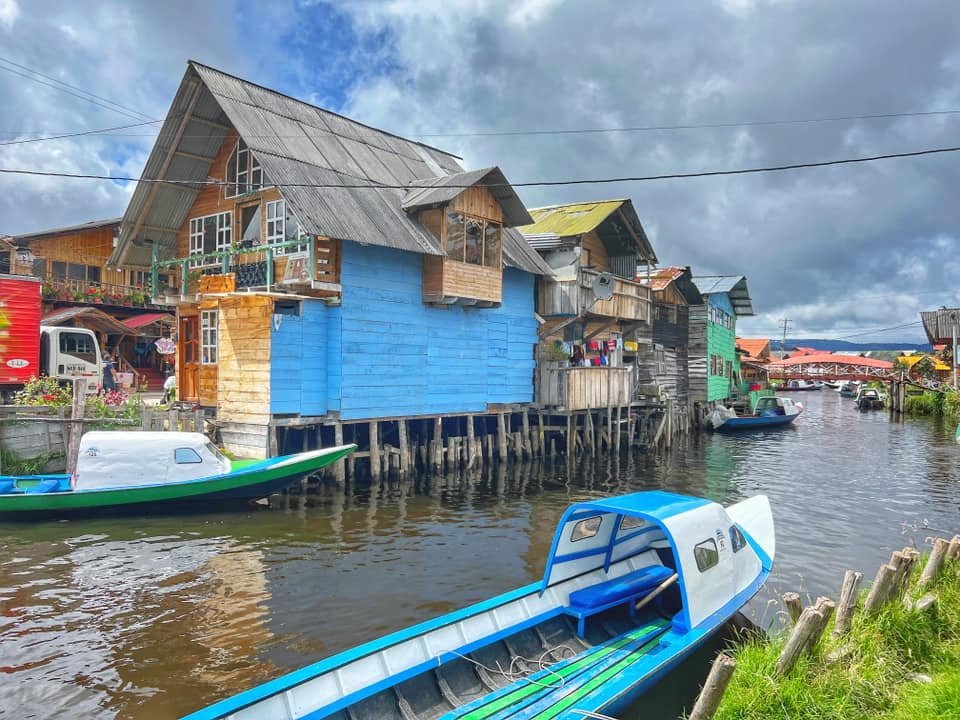
Honorable Mention: Laguna de La Cocha, Colombia
In a land of picture perfect villages, of course we have to recognize one in Colombia, even though we were only there a limited time on this leg of our journey. From Pasto, we took a day trip 45-minutes east to Laguna de La Cocha, which was a whole different side of Colombia. In fact, although the powerful palette of colors and general air of cuteness fit Colombia, this tinker toy resembling village felt nothing like it. The lakeside village of El Encano felt more like stepping into a child’s picture book, with its diminutive brightly hued lancha fishing boats meandering on a curving canal, eclectic Lego-esque bridges and curious trucha (trout) restaurants and homes balanced precariously on stilts. Read more.
Most Captivating City


Buenos Aires, Argentina
We have unexpectedly fallen in love. When we visited the “Paris of South America” in 2016, we knew we found her attractive and wanted to return. But the truth is, in those ridiculously short two days, we didn’t even have a chance to bud a romance. But during this year’s rendezvous, when actually living as part of a local community, we experienced some of the genuine, and not just tourist culture, which is essential is a city like Buenos Aires. We met local friends. We took yoga classes and built relationships with shopkeepers. It easily launched itself into our top three world cities list (1million+). (The other two are Istanbul and Prague.) All this said, we’re almost always ready to leave a place, but as of our departure date after a month, we were only longing for more. This is a city we are positive we’ll return to again and again. Read more.


Honorable Mention: Cuenca, Ecuador
At an elevation of 8500 feet (2560 meters), the historic colonial and cultural center of Cuenca is the cobblestone on the cake to what is already a gorgeous and livable city. Like nearby areas in Colombia, Cuenca is known for its eternal spring temperatures and for so many reasons inched into a spot as our favorite city in South America (but this was before our month in Buenos Aires). This may come as a surprise for those who know of our love for Colombia. However, it is the villages of Colombia that hold our heart, not the cities.
Cuenca, at least from first impressions, had it all…quiet (comparatively) and clean streets, a pleasant climate, welcoming people, lush green parks, meaningful culture, a safe environment, availability and value in goods and services, access to a national park and so much more. The name Cuenca means “basin,” which seems appropriate for the four flowing Andean rivers which traverse through it. The city is know for its textile making and flowers, as well as straw hats known around the world as “Panama hats” but are in fact made in Cuenca by local artisans. It’s also notably one of the most beautiful cities in Ecuador and home to many expats, with very good reason. Read more.
Most Epic Scenery



Andes Mountains & Mount Aconcagua, Mendoza Argentina
Besides the overflowing rivers of wine, another amazing thing about being in Mendoza is easy access to the simply stunning and snow-peaked Andes Mountains, which includes Mount Aconcagua, the highest peak in all of the Americas at 22,837 feet (6,961 meters), which outshines Denali by about 2,000 feet. It’s also a spectacular place for a road trip so we were very fortunate to be with Greg’s parents and have access to a car! However, it really whetted our appetite for a return trip where we have a little more opportunity to hit the trail.

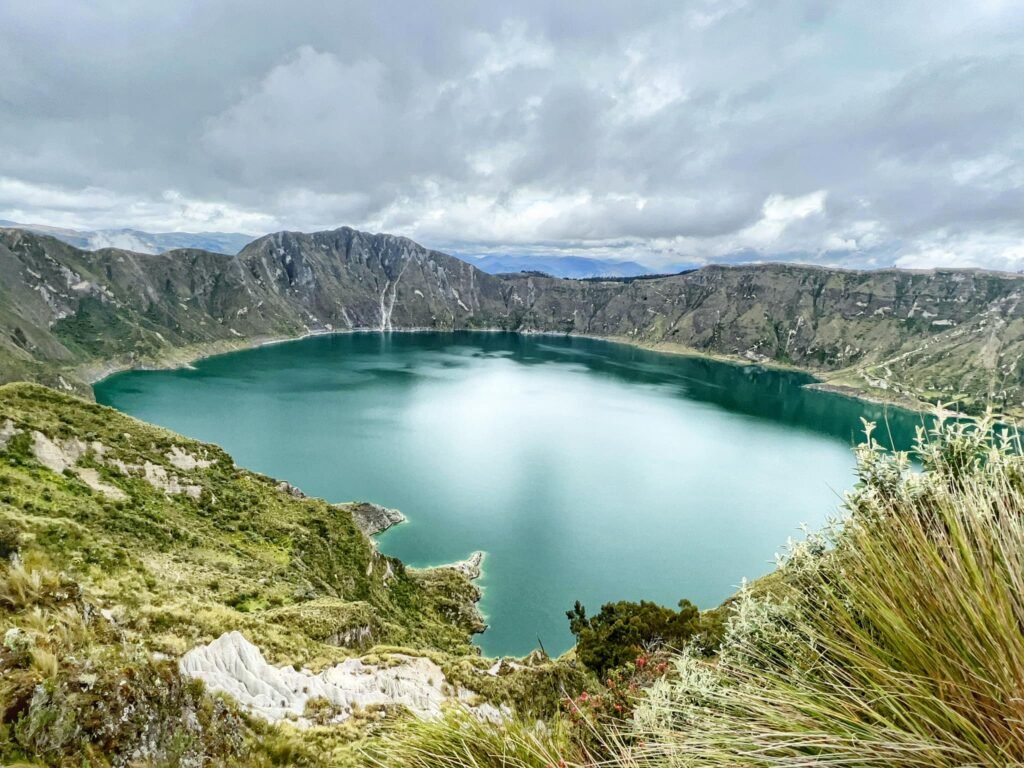
Honorable Mention: Quilotoa Loop, Ecuador
The Quilotoa Loop, which is not even a loop at all, is arguably the most popular hike in Ecuador. And for good reason. It can be done independently in three nights total and takes you through some stunning Andean scenery and farmland, allows you to stay in remote villages where almost everyone dons the image of a traditional Ecuadorian and ends with the breathtaking cratered Quilotoa Lake. Quilotoa Lake itself is a remarkable 3-kilometer wide cratered lake that was formed during a volcanic eruption only 800 years ago. It is 250 meters (820 feet) deep and its distinct color comes from the dissolved volcanic minerals remaining from its past eruptions. The water is extremely cold and volcanic minerals are abundant, so swimming is a big no-no. Read more.
Best Man Made Wonder


Christ the Redeemer & Rio de Janiero
Christ the Redeemer, towering over Rio de Janiero at 2,310 feet (704-meters) is undeniably the most iconic image of Brazil and one of earth’s new seven world wonders. The colossal wonder itself, the largest Art Deco style sculpture in the world, is 98 feet (30 meters) and was completed in 1931. Seeing it in person leaves you a bit awestruck, especially because of the surrounding views of what is easily the most beautiful modern city we’ve ever laid eyes on. Although the harbor itself is of course not man made, the way the surrounding magnificent nature is knitted with the urban environment its truly one of the most breathtaking cityscapes we’ve ever seen. Read more.

Honorable Mention: Las Lajas Cathedral, Ipiales, Colombia
It might look like it, but no, we’re not in Europe. Balanced in the ravine of a very different ColOmbia River Gorge, one can find a sincerely stunning spectacle of God meets nature near the Colombia/Ecuador border. The Neo-Gothic Catholic church, built between 1916-1949, has a powerful legend, which led to it being built in the most dramatic setting we’ve ever seen a religious structure. It took about 20 minutes to get there from Ipiales by collectivo (mini bus) and made the city well worth an overnight stay. The church and grounds themselves are free to visit. Read more.
Best Splurge


Salar de Uyuni Tour, Bolivia
Salar de Uyuni, the largest salt flat on earth, is so vast that its 10,582 kilometers of barren, salty crust can be reflected from space. Despite being surrounded by Andes, it’s also the flattest place on earth and sits at 3,660 meters (12,000 feet) above sea level. The grand white expanse was created between 30,000 and 42,000 years ago as the evaporated legacy from dozens of prehistoric lakes.
Over the past few years, thanks in part to a social media explosion of forced perspective shots many travellers fantasize of reaching the middle of the salt flat where there is nothing but a 360-degree view of emptiness. It’s simply a surreal stark white blanket that plays tricks on your eyes because you feel it should be cold…or slick…and instead, all you’re encompassed with is the fierce sun rays, the powerful reflection, and some of the bluest skies of your life. That said, when choosing your tour, it’s very important to have a guide who is a creative and accurate photographer! We were very happy with Marco, from Brisa Tours who truly went above and beyond throughout the course of the 12-hour day, which was a terrific value at $29/each, plus tip, and included lunch.
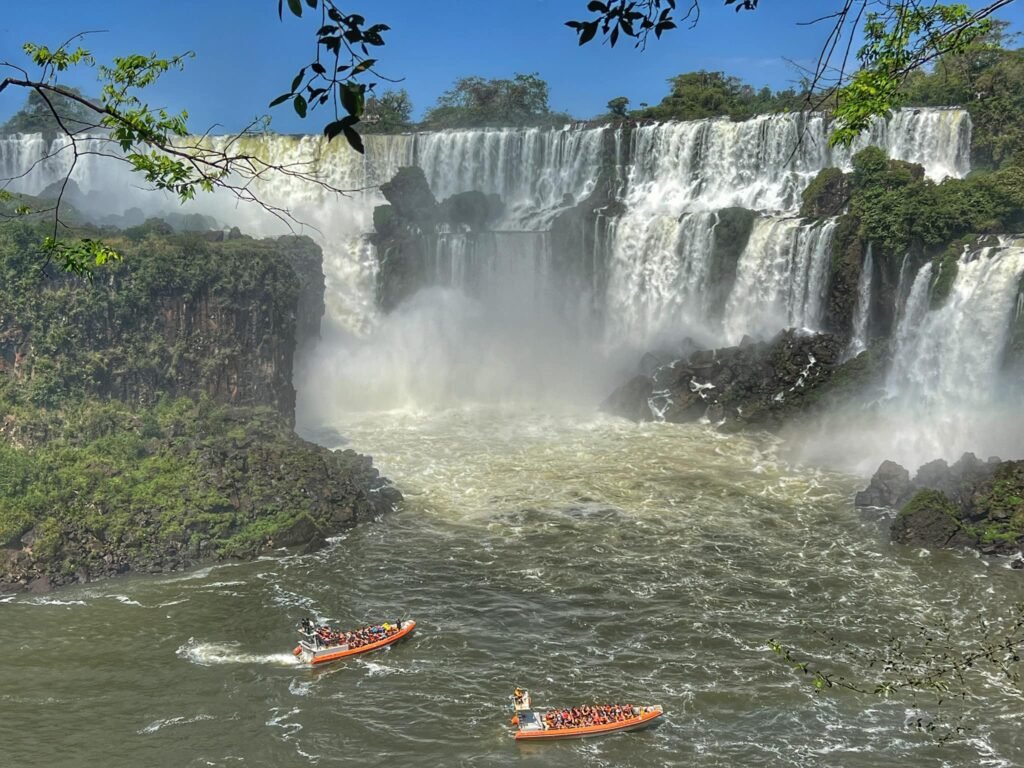
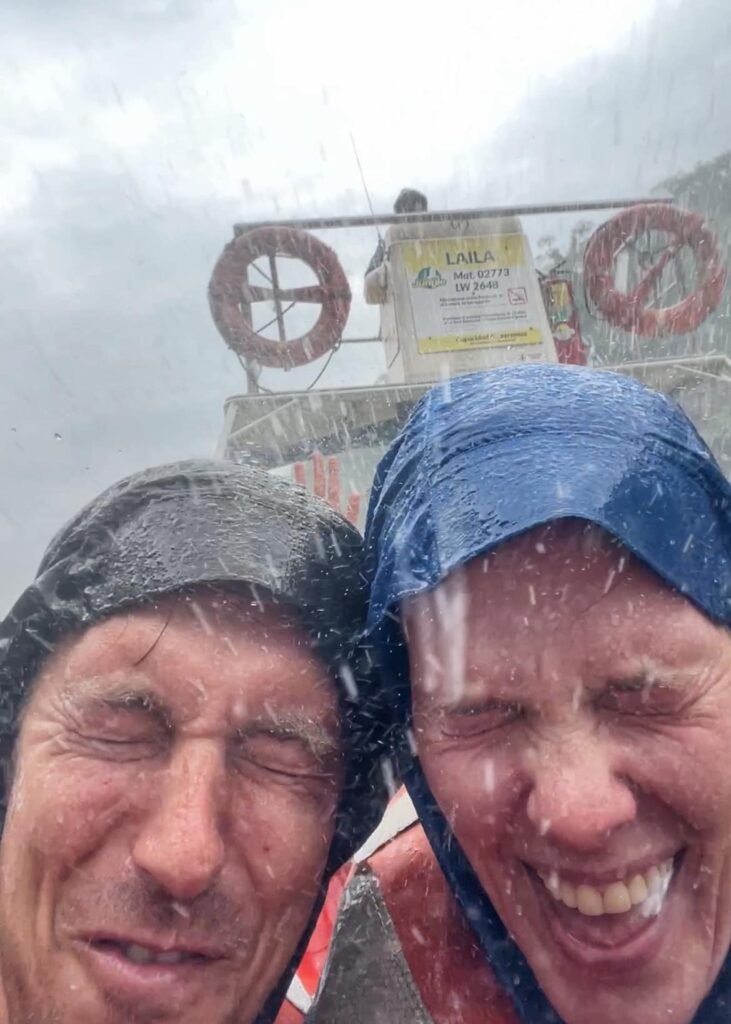
Honorable Mention: Iguazu Boat Ride, Iguazu Falls, Argentina
Iguazú Falls is one of those visceral awe-inspiring experiences that everyone should experience once in their lifetime. The earth’s largest waterfall (closely contested with Victoria) has a wingspan of nearly three kilometers (1.8 miles) of pummeling cascades, which are stitched together on the Brazil/Argentina border. It is ringed by luscious subtropical rainforests teeming with flitting colorful butterflies, melodious birds and frisky monkeys. If it’s not already on your life list…add it. It’s a memory that you’ll never forget.
When we met our friends, Brian & CC in Rio de Janiero, they advised to us to absolutely not miss an up close and personal view of the falls on the Gran Adventura boat ride when we went to Iguazú. Turns out, they were right. It was completely worth the splurge, the submerge and the highlight of our days at the parks. We bought our tickets online through Iguazu Jungle tours the day before our adventure because they had already sold out for the first day of our visit to the park. They cost 27,000 pesos or about $39/each. If you missed our bird’s eye view from the day before, the day was a lot different than we were granted with on game day. But who really cared?! The intent was to get pounded by Pachamama. (Mother Earth.)
Most Unforgettable Transit Experience
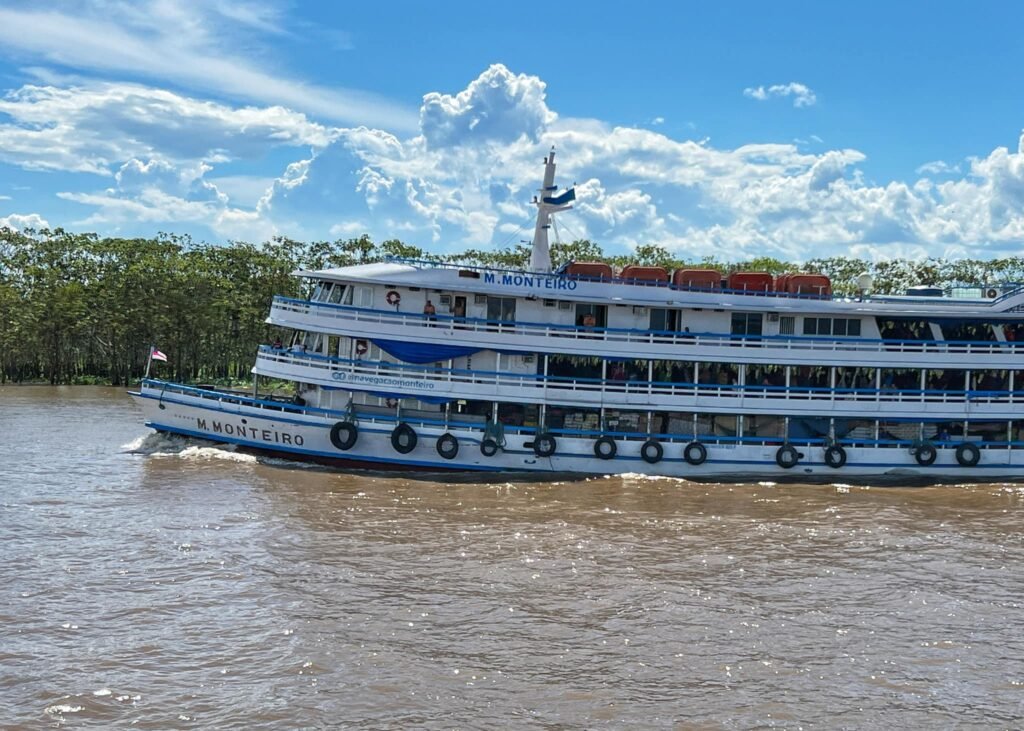

Slow Boat down the Amazon, Tabatinga to Manaus, Brazil
From Letitica, there are two ways out of the Amazon. The easy way we came in (by plane) or the hella more interesting way (by river.) Within those water options, there are two boats: One is the expensive “speed” boat, which still takes 36 hours to get to Manaus (the nearest city in Brazil with an airport) and costs about $160 USD/person. The second is the slow boat which takes ~72 hours and costs $57/person and includes all meals. The epitome of slow travel. After our splurge at Palmari Nature Reserve, there was no question which we’d be doing. Plus, the adventure of stringing up a hammock and hanging with the locals for an extended period sounded pretty fun….in theory. This is also where we met CC & Brian, our American friend that’s been to every country. As you can imagine, that’s kind of rockstar status in our eyes.

Honorable Mention: Hairpin Turns & Landslides, Guayaquil to Cuenca, Ecuador
Driving through the Andes during the tail end of rainy season was a new adventure. Fortunately, our driver handled the road with caution and care, but more than once we saw recent landslides where people, including our bus assistant, literally had to get out to help clean off the road. At one point we also saw rock barreling down the hill directly at our bus. Fortunately, they were small pieces and the bus darted out the way just in time.
Best Off-the-Beaten-Path Destination


Tiradentes, Brazil
Tiradentes is a gold mine in many senses of the word. Nearly completely off the radar for most international travelers, the rural colonial wonder, home to only 7000 people, was once a booming gold town. Today it is replete with outdoor wandering, artisan goods and crafts, and the second best cuisine we’ve sampled in South America (Peru will forever hold the prize.) While it doesn’t offer the colorful palate of Paraty, nor the distinguished elegance of Ouro Preto, there is something very quaint and authentic about the way the white facade and terra-cotted architecture blends into the mountain backdrop and the blue bell skies. In short, it was one of our favorite stops in Brazil. Read more.
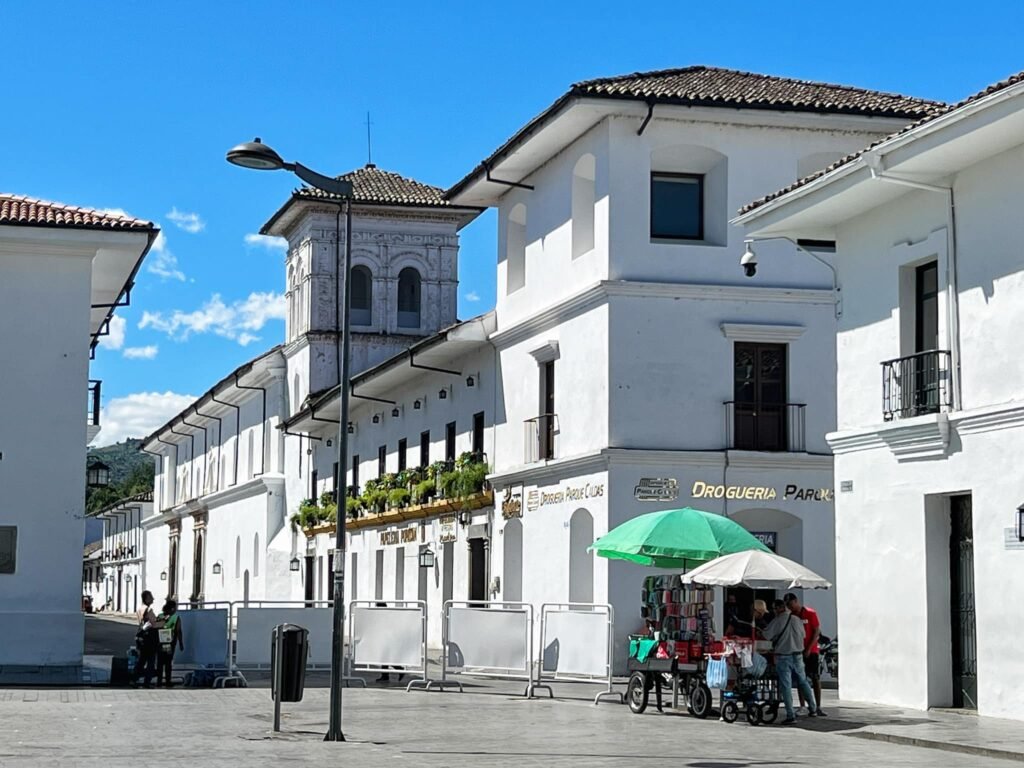

Honorable Mention: Popoyan, Colombia
Popoyán, known as “Ciudad Blanca,” is a ravishing gem in Colombia…a ravishing gem that very few talk about. But this spellbinding city of less than 400k is well worth a visit especially because it is second in historical colonial preservation only to the city of Cartagena. But the reason we loved it more? Unlike the booming Caribbean city, hardly any foreign tourists were here, which meant it was far cheaper as well. In our opinion, it’s seriously underrated. In fact, it easily shot to the top of the list as our favorite larger city we’ve visited in Colombia. Read more.
Most Regrettable Departure
Mendoza, Argentina
It’s not really a surprise that both our awards in this category go to Argentina. It’s unbelievably easy to fall in love with its people, its scenery, its wine and its value. Mendoza was our last real stop before returning to the States in December, so it made it extra bittersweet. The city of 1.9 inhabitants is a global powerhouse for wine production and has incredible park-lined streets with similar cafe culture to Buenos Aires, and with a bonus of the looming Andes Mountain. Although we only stayed five nights, it’s a city we can imagine spending at least a month, maybe longer. We were definitely not ready to leave.
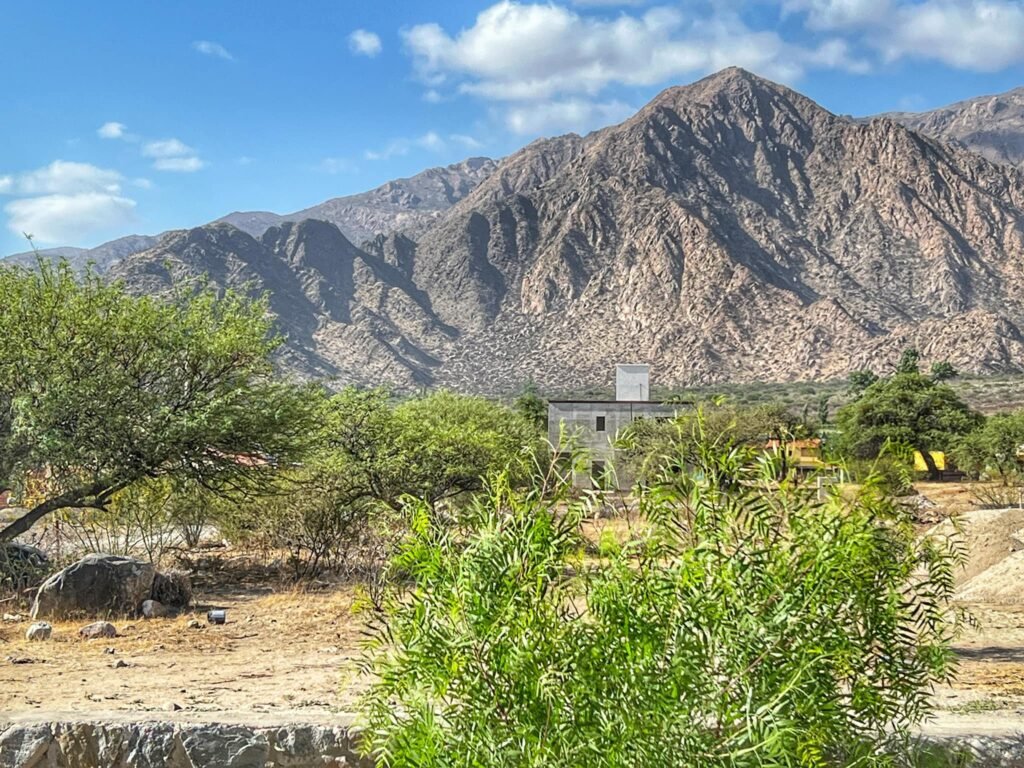

Honorable Mention: Cafayate, Argentina
Most people don’t know this, but we’ve always said IF we ever move back to the States, it would very likely be to New Mexico. We adore the bright sunny skies, the cooler red rock desert landscapes, the Wild West vibes, and the genuine diversity of its people. We’ve now found our “New Mexico” in Argentina and love it even more after three nights. But the bonus of this place other than the obvious cost factor? It’s also a lesser known Vino Utopia of absolutely delicious high altitude wines, the highest in the world in fact. Cafayate also produces some very unusual wines from grapes that aren’t common in other parts of the world, including Torrontes. Cafayate is also just a comfortable town with decent food and hiking options, and three nights was far from enough time to really experience it.
Most Unbelievable Moment

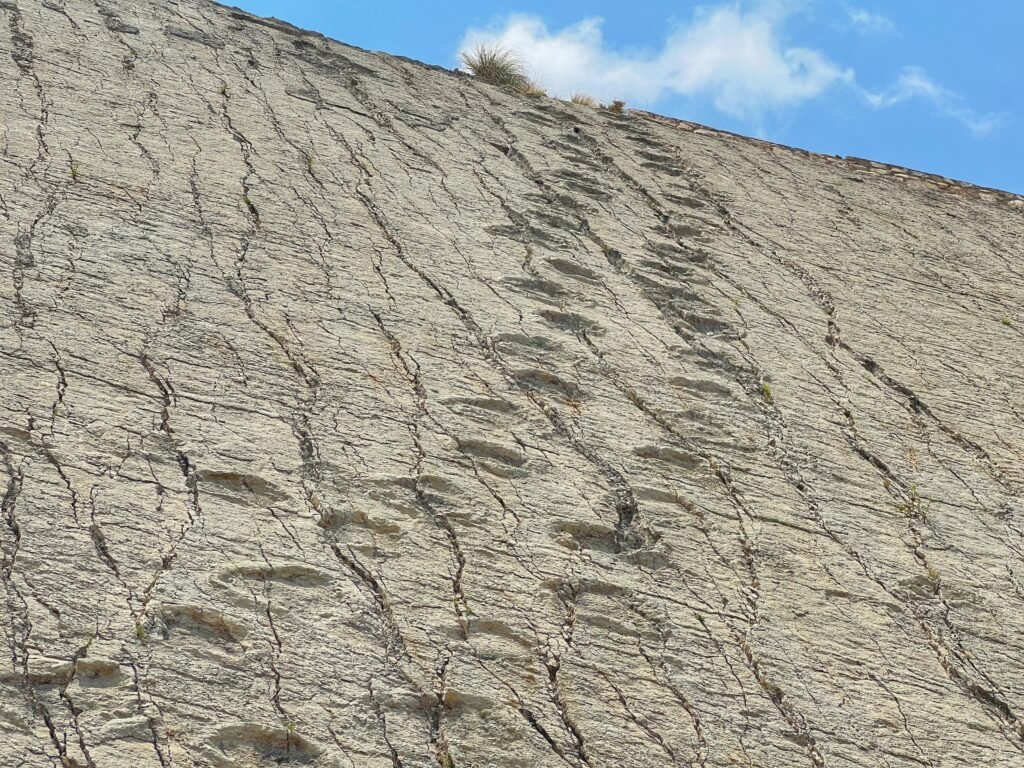
Dinosaur Footprints, Sucre, Bolivia
When you learn about dinosaurs as kids, you think of them as really cool and mythical beasts that once roamed the earth. But when you come face to face with their real footprints as an adult, particularly grazing the side of a soaring cliff, a holy crap awakening is inevitable. These giant reptiles actually ruled the planet and plodded amongst the terrain we live on today. El Parque Cretacico, or Cretaceous Park is the largest paleontological site in the world and features more than 12,000 footprints of 294 species. It is one of the most mind-blowing things we’ve ever seen.

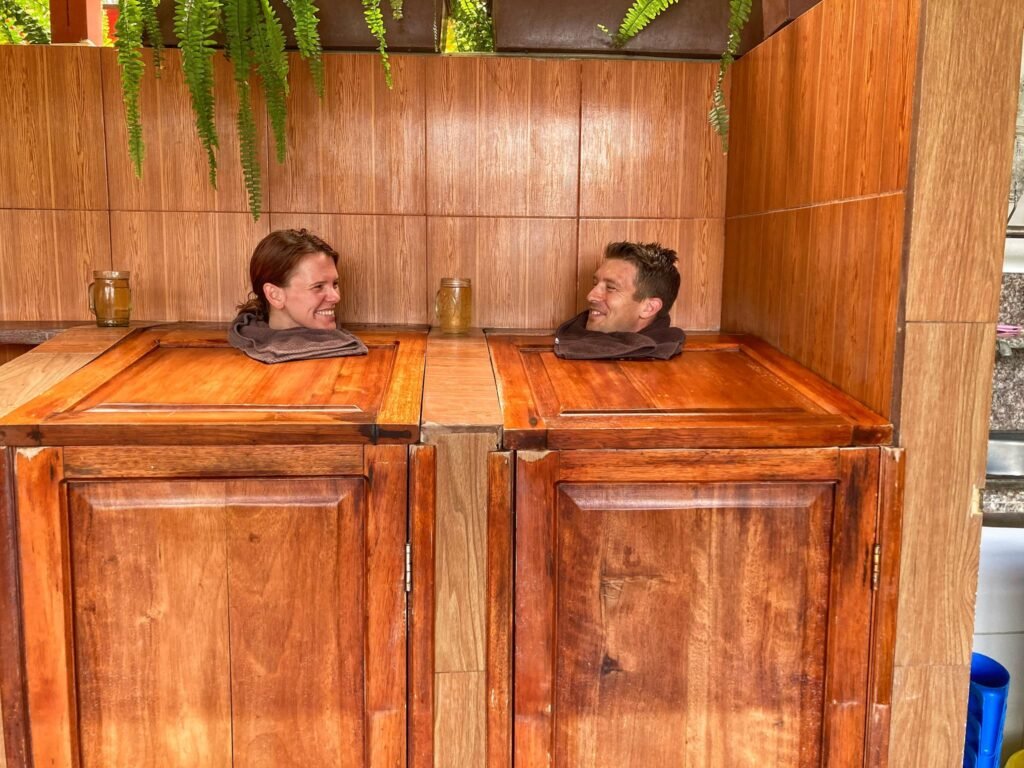
Honorable Mention: Sweat Box Treatment, Baños, Ecuador
To celebrate Greg’s 45th cumpleaños, he wanted nothing more than a lazy day at the spa for his birthday. Fortunately, we were in Baños, a town ringed with world-renowned hot thermal waters so for $70/each, we got a 75-minute hot stone couples’ massage (our first!), a 45-minute sweat box treatment, a mud mask, and ample time plunging between pools of varying temperatures all in an incredibly beautiful setting at El Refugio Day Spa. The Baños de Cajon (sweat drawer) was the first experience we’d had of its kind and one we’ll always remember after being guillotined and basted like a turkey. Read More.
Best Outdoor Adventure

Camping in a hammock in the Amazon, Brazil
We must admit, over the years we’ve watched way too much of the TV show, Naked and Afraid or “Supervivencia Al Desnudo” as it’s called in Latin America. Thus, due to visions of this show and mosquitoes realistically, we actually debated whether or not to do the overnight camping trip in the Amazon at Palmarí Nature Reserve. Of course, not doing it would have been a serious mistake as it ended up being one of the most unreal experiences of our lives. But over time, we’ve definitely learned, “The walls of your comfort zone are lovingly decorated with your lifelong collection of favorite excuses.” Thus…always say YES!!!
It began with a fairly easy, but very steamy hike of about two hours led by our warrior guides, Hugo and Marcos. In addition to guiding and pointing out bizarre jungle flora along the way, they proceeded to do all the work of setting up our hammocks (con super strong mosquito nets!), cooking the finest fish of our lives over the fire, and taking us on a night walk. Read more.

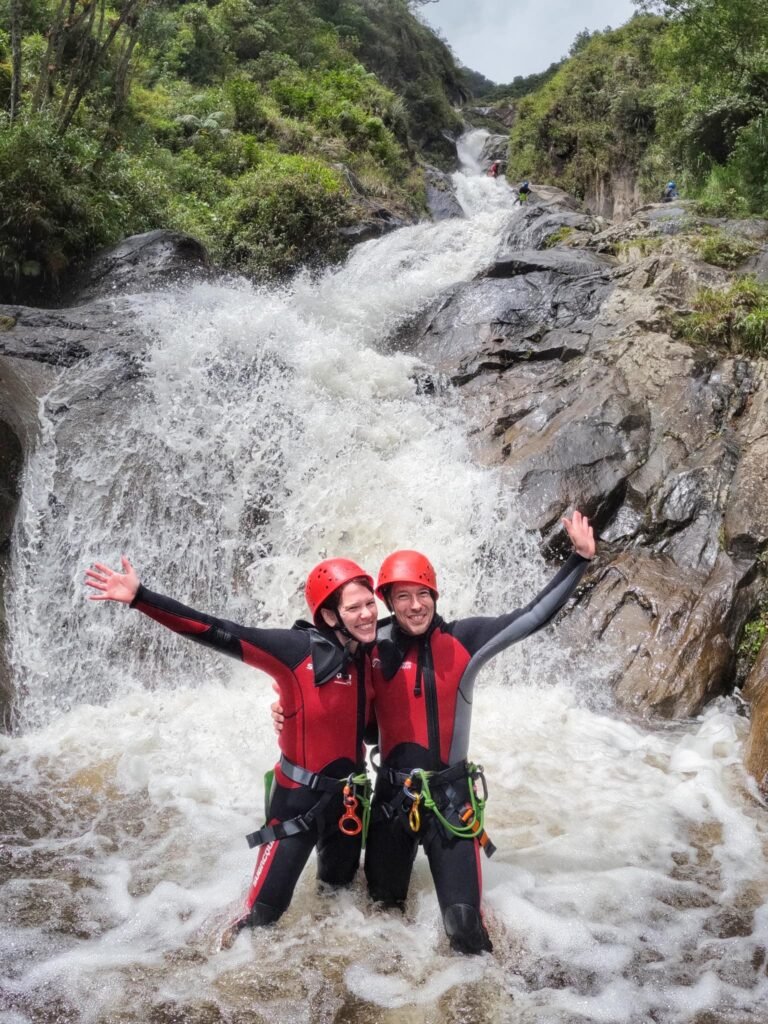
Honorable Mention: Canyoning & Waterfall Rapelling, Baños, Ecuador
There’s no better place in Ecuador for outdoor adventure activities than Baños and since canyoning has been high on our list for years, and…also since we’re not getting any younger, it was time to leap off some waterfalls. For those that aren’t familiar, canyoning is the sport of exploring a canyon by engaging in such activities as rappelling (abseiling) and waterfall jumping. We chose Ivagatours for our three-hour adventure which cost $30/each and included two waterfall rappels, one waterfall slide and a final plunge off the 30-meter (98 foot) Cascada del Silencio. And yes, we dropped plenty of f-bombas. It. Was. Intense. It was also wildly fun, and worth every cent. One of us…(Mandy ![]() )…would do it again in a heartbeat! Read more.
)…would do it again in a heartbeat! Read more.
Amazing Animal Encounter
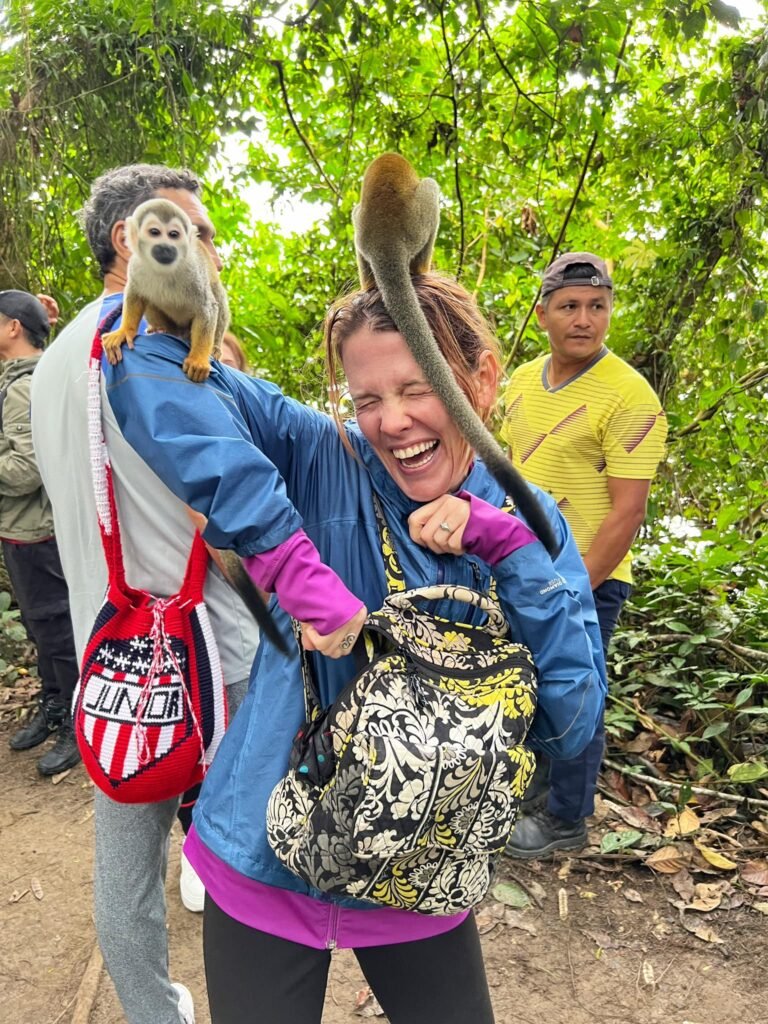

Isla de los Micos, (Monkey Island), Amazonas, Colombia
As part of our Amazon day trip from Leticia, we were taken to Isla de Los Micos, where we provided our services as play toys for the mischievous monkey made even more famous by Marcel, the squirrel monkey, on the first season of “Friends.” In Colombia, the squirrel monkey or Mono Fraile, is found in the Amazon below 200 meters above sea level. This endearing primate frequently uses the habitats of borders of forests. And they are cute…stinkin’ cute… even when they pounce on you, work you over like a rubber tree or delve into your hair with their soft and grubby little monkey paws.
For the record, there is not question that this is one of the biggest tourist traps on the river. Unfortunately, this island was previously owned by hotel giant DeCameron, American Mike Tsalikis, who brought the controversial monkeys to the island in the ’70s. At the time, the animals were sadly sold mainly for experimental and exotic animal purposes, but experiments were also carried out on animals at the site. Thankfully this practice stopped as of the 1990s and it is now owned by a non-profit which protects the monkeys. Read more.


Honorable Mention: Pink River Dolphins, Amazonas, Brazil
On our Amazonian kayaking trip, which went through the flooded forest and then out into the open river, we were astounded to become entirely encompassed by pink boto river dolphins, which takes the grey sea dolphins we’re accustomed to seeing to a whole new level. These freshwater dolphins are quite common throughout the Amazon and are friendly and curious. The brighter the pink the more attractive the males are to females. Naturally.
The pink river dolphin is the subject of an interesting legend in the Amazon. It is believed that in the evening, the River Dolphin can transform itself into a man, hypnotizing and seducing unsuspecting, young women. (Source: Rainforest Cruises) Of course, catching them in action is a bit of a challenge. We probably tried to film and observed them playing peekaboo near our kayak for an hour and this was the best video-to-photo shot we managed. That said, the experience is not something that could ever be captured in photos or videos. It must be lived to really understand how beguiling being surrounded by unicorn-like pink dolphins can be. Read more.
Most Mouth Watering Meal
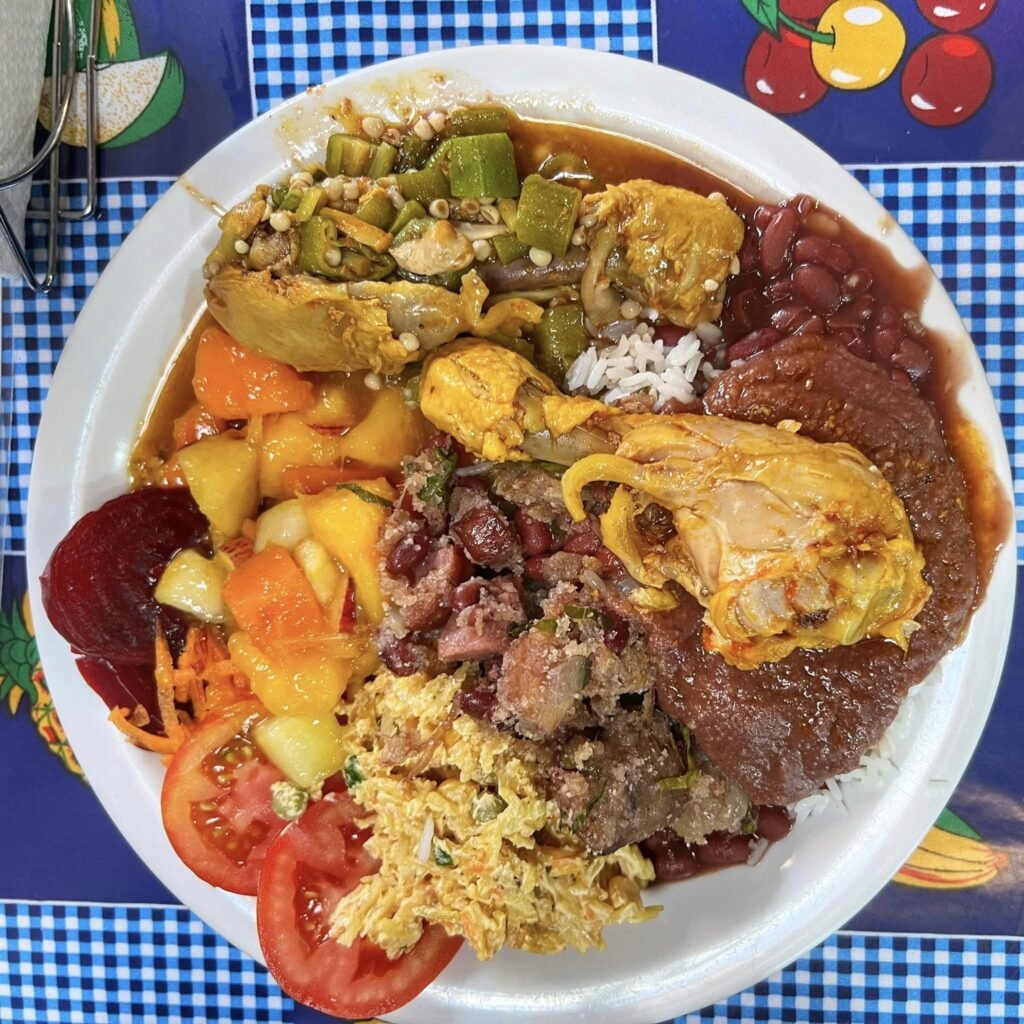

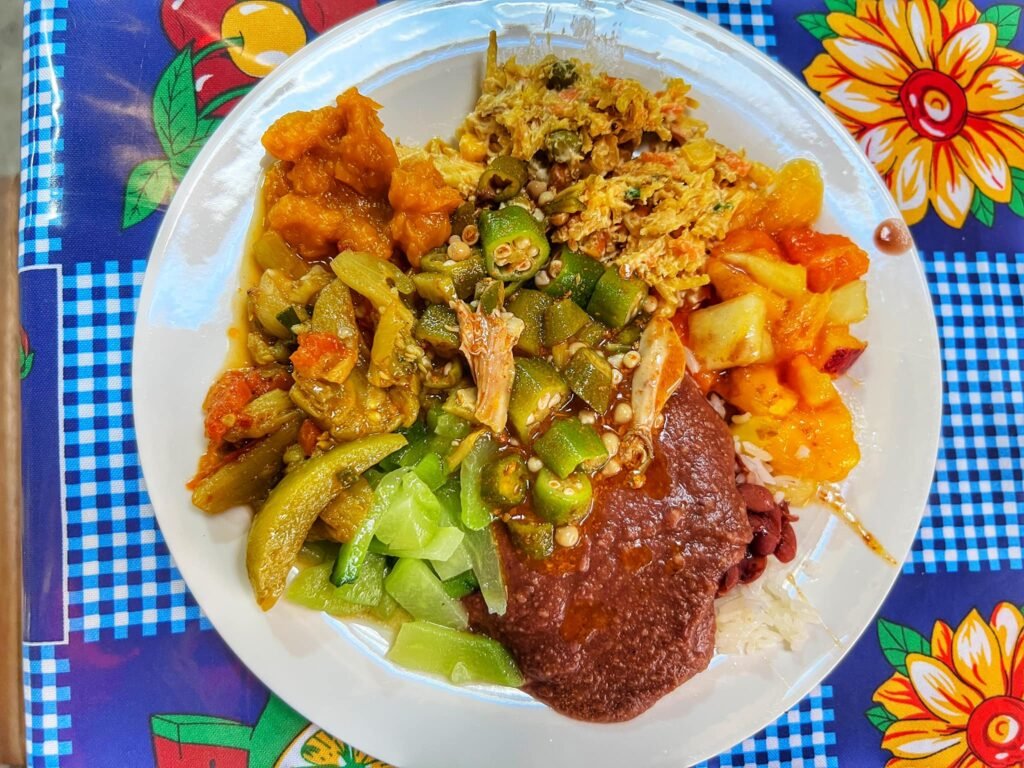
Restaurante Tempero da Angela, Bichinho, Minas Gerais, Brazil
Foodie alert! Tiny Tiradentes, in the Brazilian state of Minas Gerais, is a culinary powerhouse that you may have never known existed. With a minuscule population of 7000, it has more starred restaurants per capita than any other city in the giant country of Brazil. Five to be exact. It also offers some of the best food we’ve had in South America (minus Peru) in its traditional mining, or Minas Gerais cuisine. Our favorite and best value, which we walked to nearby Bichinho for was at Restaurante Tempero da Angela. This food, slow simmered in cast iron or stone pots over open flames, for us can only be described for us Americans as the kind we grew up eating for Thanksgiving. You know, until we were so crammed with calories all we needed was a nap….savory, creamy, overindulgent comfort food. But, the flavor palate is also bursting with new variety and concoctions as well, not to mention fully accepting of vegetarians. Two all-you-can-eat plates cost about $100 Reais or $20.
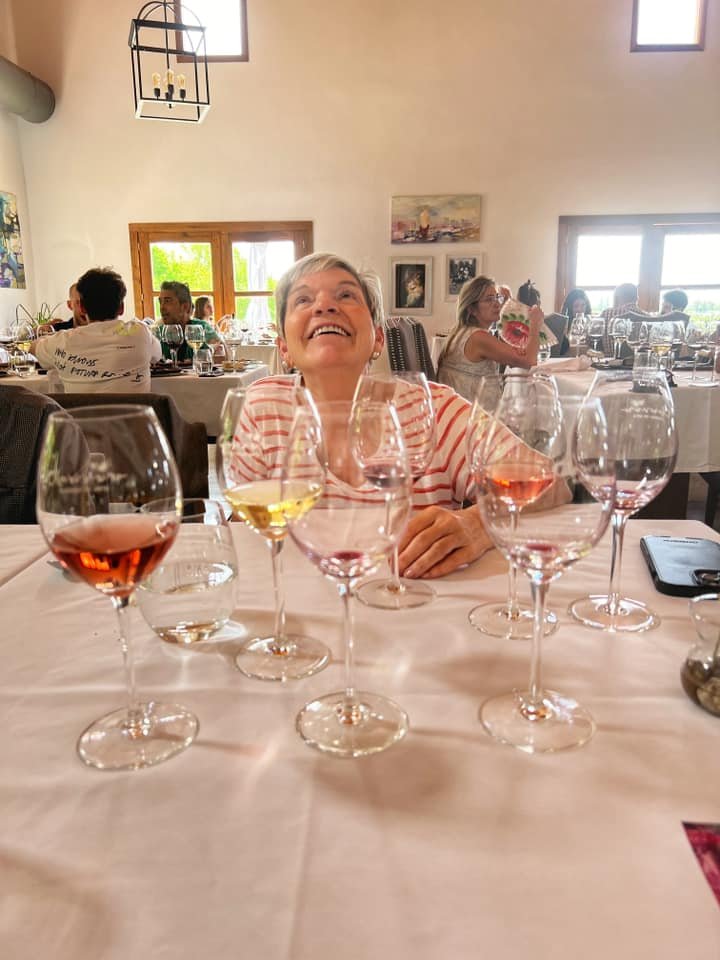

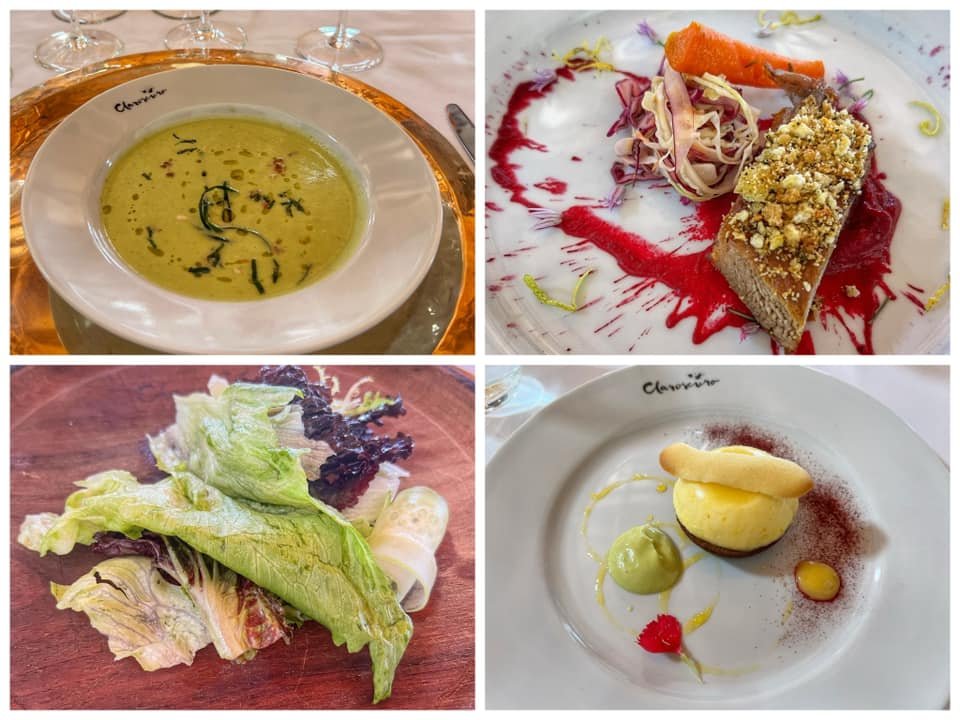
Honorable Mention: Claroscuro Winery lunch with wine pairing, Mendoza, Argentina
This was a one-of-a-kind wine experience of a lifetime. It featured four courses: zucchini gazpacho, pork in a beet emulsion, green salad and an orange cream brownie with avocado foam. The main course for the carnivores was two giant tomahawk beef hunks and chimichurri sauce. (Of course… we were in Argentina.) There was SO much food and they even asked if we wanted another steak of beef for no extra cost. They also offered delicious vegetarian options. It also offered five wine pairings, including the most divine Malbec we’ve ever had, English-speaking servers and a great attention to detail in terms of allergies and food restrictions. For those of you wondering the price, with the Blue Dollar rate it was about $20/person for all this. Simply unbelievable value, which made it even more incredible.
Best Alcoholic Beverage
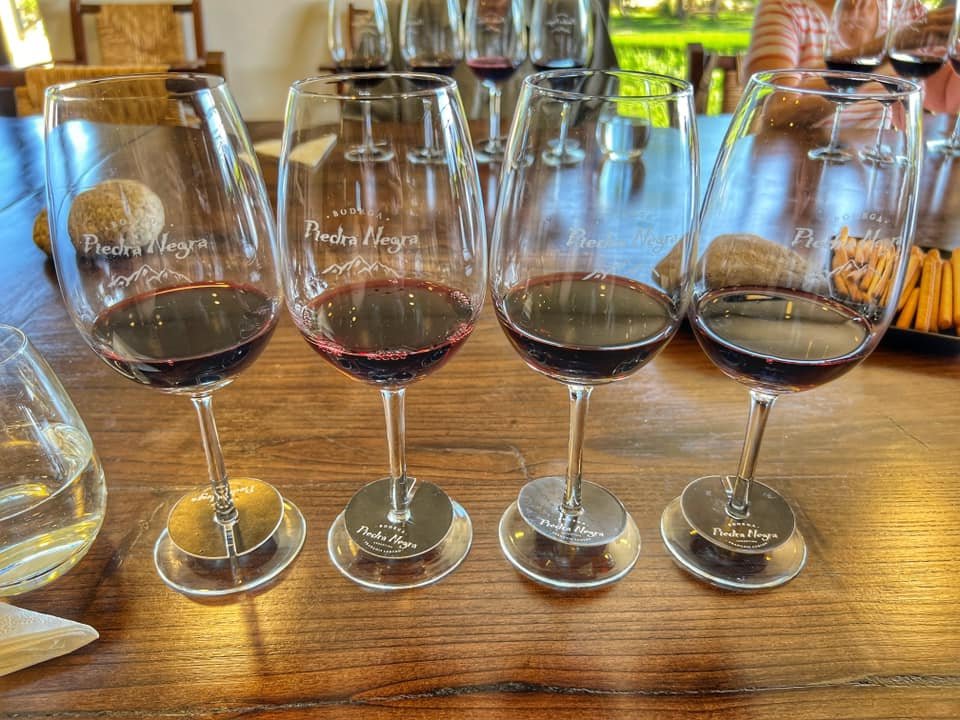
Malbec wine from Mendoza, Argentina
On the heels of the last category, we’ve had some extraordinary wine experiences around the world. Some of them include the Valley of Beautiful Women in Eastern Hungary, the wine caves of Moldova, Port tasting in Porto, and the Cascadian peaked vineyards of the Willamette Valley in Oregon, US. However, we’ve never had wine experiences quite like in Argentina. Wow. Wow! WOW!! Top quality. Top value. Top atmosphere. There is truly nothing like it. And while all the wine is amazing, even the dollar bottles at the grocery store across the country, nothing beats the Malbec itself, which is renowned for its production in Mendoza.

Honorable Mention: Craft Beer, Buenos Aires, Argentina
As if it weren’t enough to have incredible wine, Argentina also offers some unbelievable breweries where quality craft beer can be bought with the blue dollar rate for as low as $1 a pint, with the normal cost being around $2. These craft breweries can be found throughout the country, which we experienced in Sucre, Iguazu Falls, Tucaman and Mendoza, but Buenos Aires definitely boasted some of the best.
Best Day Hike
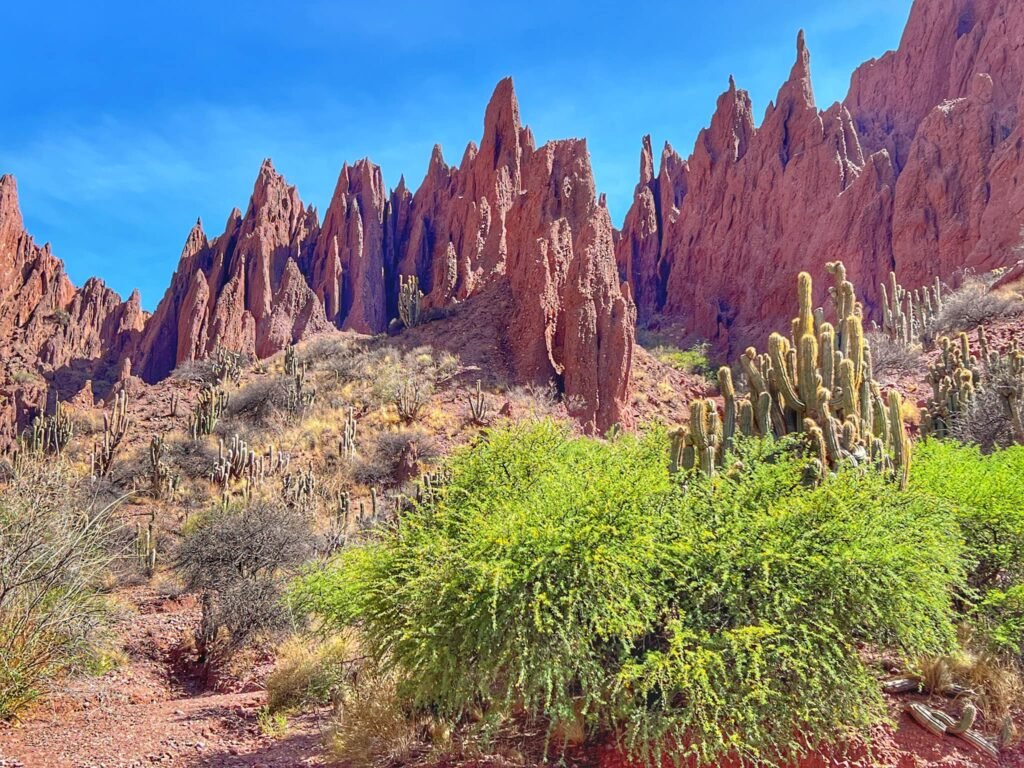
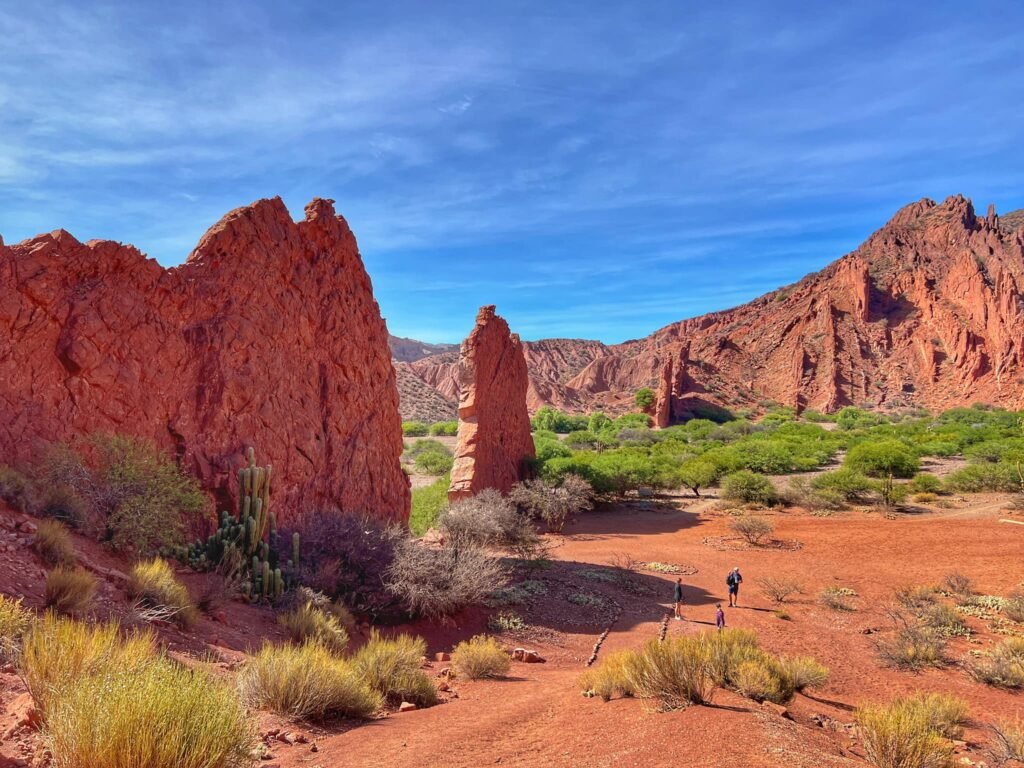
Tupiza Canyons, Bolivia
We absolutely loved independently hiking in Tupiza, a small town in southwest Bolivia. (Elevation: 2580 meters, or 8464 feet). The weather was perfect, the rock formations extraordinary, and the canyon and red rock trails were incredibly reminiscent of the US Southwest, a place we’ve always loved hiking. The ~13k, 5 hour trail took us through three iconic sites: Puerta del Diablo, Valle de los Machos and Cañón del Inca. Plus, we got to enjoy it with our Dutch friends, Roos and Bob, who we unexpectedly got to travel with for several weeks. Read more.

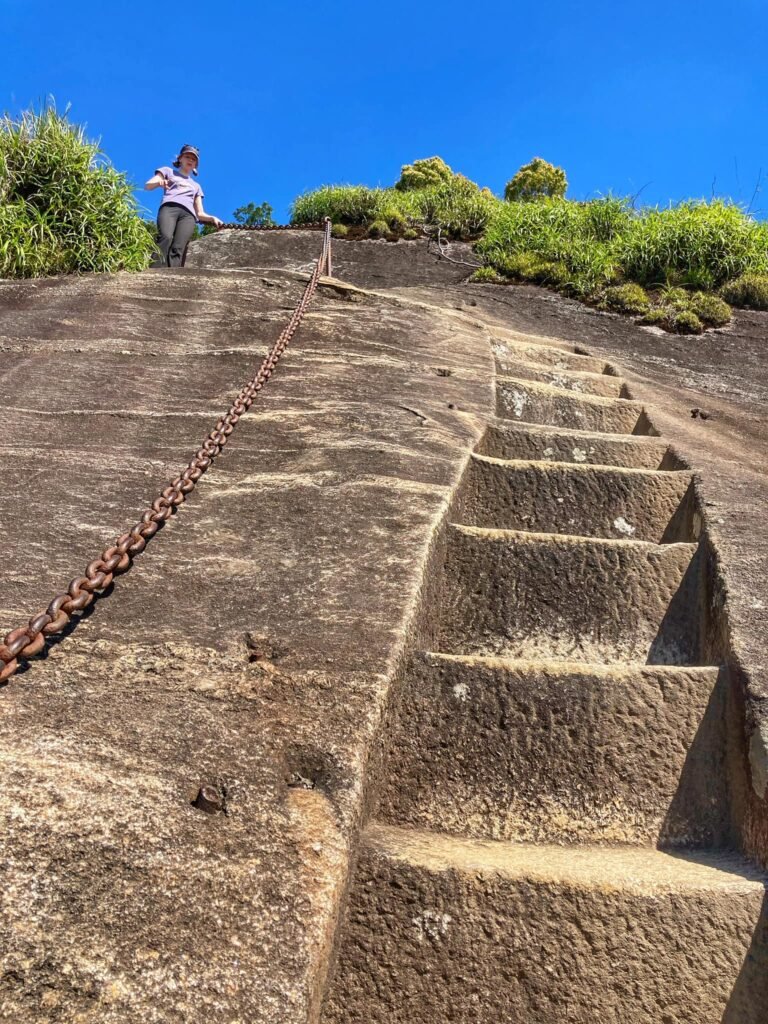
Honorable Mention: Pico da Tijuca Stairs, Rio de Janiero, Brazil
We have been eyeballing the Pico da Tijuca hike for several years so we knew we couldn’t depart Rio de Janiero without scaling the vertigo-inducing precipitous stairs and absorbing the most mind-blowing panorama we’ve ever seen of a city. And bonus…we had it all to ourselves on this particular Monday. Tijuca Peak, the highest peak within one of the largest metropolitan rain-forests in the world, is part of Tijuca National Park. It is located about an hour northwest of Copacabana and is free to visitors. It offers loads of hiking trails, caves, waterfalls and sheer natural beauty, and was one of our favorite places we went while in Rio. But it’s most known for Instagrammy showpiece stone steps, with good reason, which is at the end of the Pico de Tijuca hike. Read more.
Best National Park
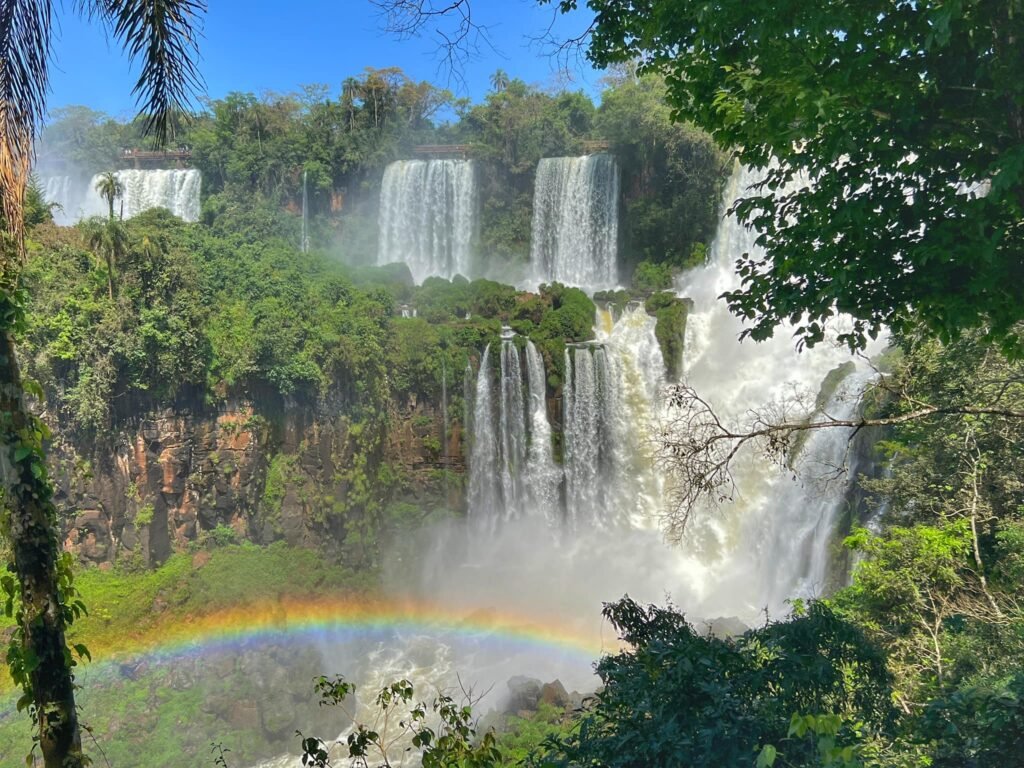

Iguazu Falls, Brazil/Argentina Border
Iguazú Falls is one of those visceral awe-inspiring experiences that everyone should experience once in their lifetime. The earth’s largest waterfall (closely contested with Victoria) has a wingspan of nearly three kilometers (1.8 miles) of pummeling cascades, which are stitched together on the Brazil/Argentina border. It is ringed by luscious subtropical rainforests teeming with flitting colorful butterflies, melodious birds and frisky monkeys. If it’s not already on your life list…add it. It’s a memory that you’ll never forget.

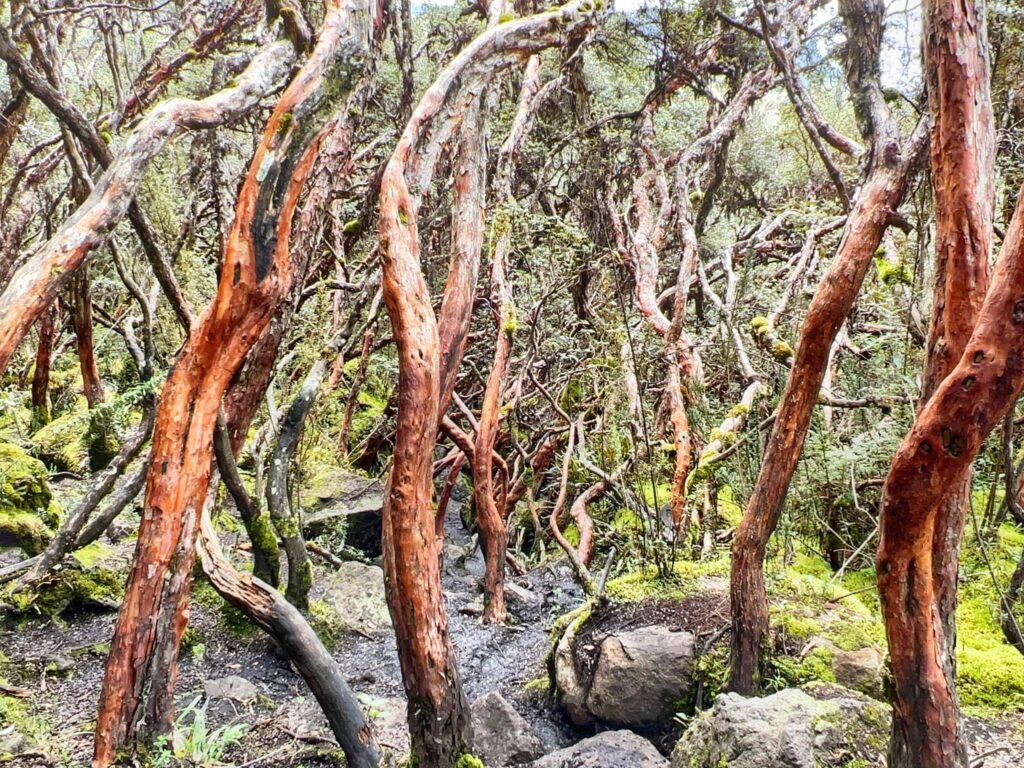
Honorable Mention: Las Cajas National Park, Cuenca, Ecuador
With rugged Scottish Highland resembling landscape and mystical forests, entering the trails of Las Cajas National Park is like penetrating another world. It has lush beds of moss and succulents, rolling green peaks, countless reflective lakes, and knobby gnarled trees that seem like they fell out of a storybook. Everywhere you looked in Las Cajas there was magic beneath your feet. But our favorite part was the forest, which was peppered with craggy crooked paper trees called polylepis. These are some of the few polylepis trees left in the country and we’ve never seen such an otherworldly forest. This park is well worth venturing to, and, at only 45-minutes from Cuenca, it’s easily accessible by any bus heading to Guayaquil from the main station for about $3/ticket. There is no cost to enter the park itself. Read more.
Most Desirable Country Overall
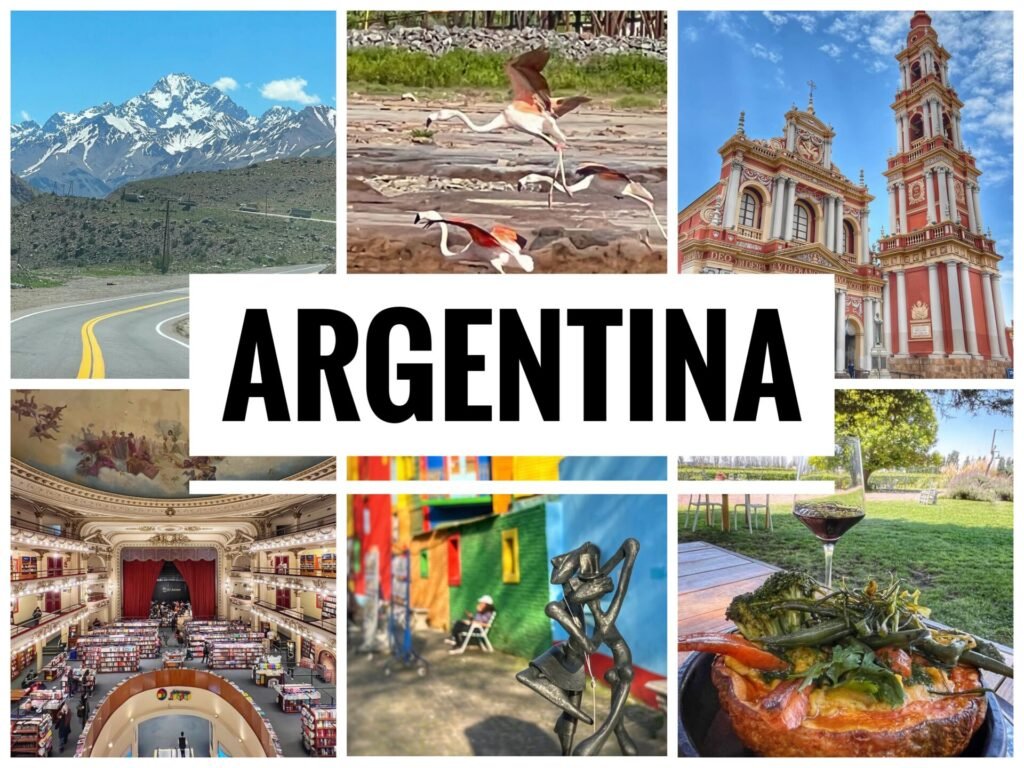
Argentina
This one is probably no surprise after reviewing our Geney Awards. When we visited Patagonia and the capital in 2016, we liked it a lot and recognized its potential. But, after a month in Buenos Aires and a month the northwest part of the country, Argentina has launched itself up our top ten countries list due to: its breadth of beautiful terrain, pleasant weather, personal safety, incredible people, off the charts wine, craft beer scene, ease of living, the ability to drink the tap water, comfortable, easy and inexpensive public transportation, cafe culture, walkability of its cities, friendly and welcoming people, (even when they might have reason not to be!), insane value due to the blue dollar rate, and a true desire to go back again and again, which for us, are all true marks that make a country a “favorite.”
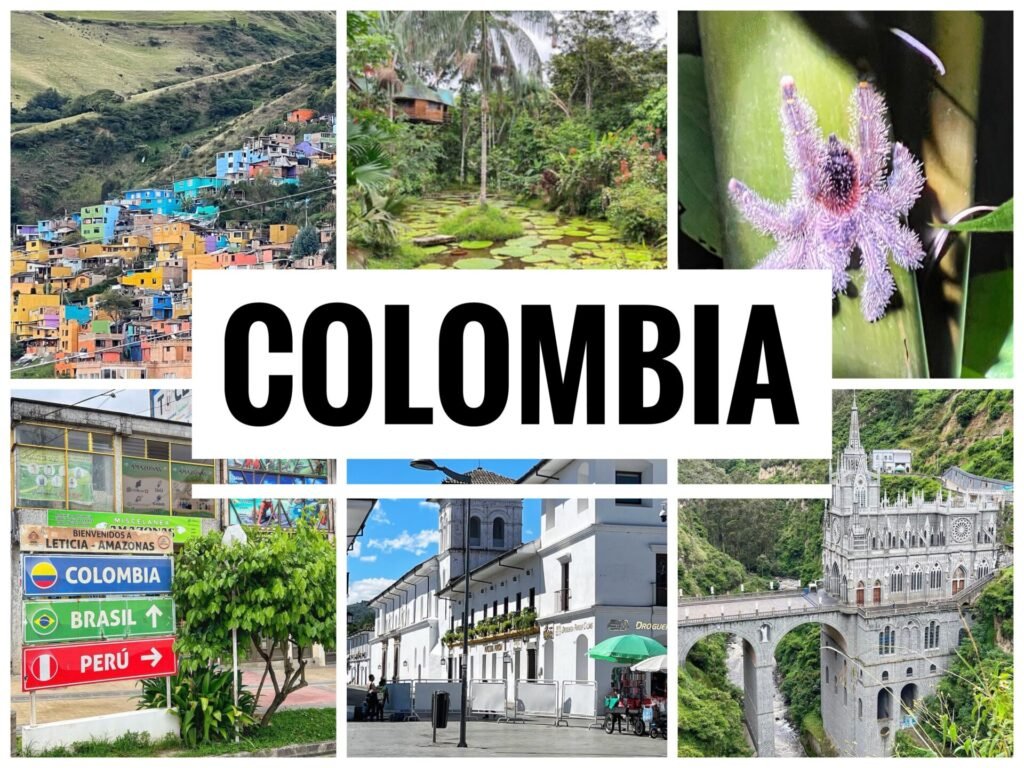
Honorable Mention: Colombia
Colombia still sparkles and when anyone asks, has been our “favorite” country overall for years. However, because we only spent three weeks in the country in 2023, we felt the title should go to Argentina. Colombia is a country that truly has it all…every type of terrain: Mountains—from the rolling green option to the snow-capped and volcanic variety, aqua blue Caribbean beaches, sweltering Amazonian jungles, and rippling farmlands. It has every type of climate—from hot and humid, to eternal spring, to cold and rainy. It is super easy and cheap to use public transportation. It has a robust local tourist infrastructure making accommodation, sightseeing and food options plentiful and competitive. It boasts functional and modern cities and the most vibrant and colorful colonial villages. The country is safe, despite the predominately tarnished worldview that many people have, still hanging onto 1980s/90s Narcos stereotypes. Colombian Spanish is easy to understand and speak…most of the time. And when it’s not, the locals are helpful, friendly and polite. Customer service is the real deal. It’s the only country we’ve ever been in where a taxi driver gave us money back because he “got lost and took too long.” Oh, and the icing on the cake? It’s easy to get up to a six-month visa. Living and traveling here is very doable on $40/day.


